|
Duomo
Santa Maria Assunta
Piazza Duomo |
The word duomo comes from the Latin domus, meaning the house
of the Lord. So nothing to do with domes.
History
The first church on this site, traditionally said to date from the 7th
century,
was destroyed by fire during the Hungarian invasion of 899 and rebuilt and
consecrated on 29th December 1075 by Bishop Ulderico. This church was badly damaged by
the
earthquake on the 3rd of January 1117 and rebuilt in Romanesque style, in
the
1120s, this church can be seen in Giusto de' Menabuoi's frescoes in the
Baptistery. Another church was built by Bishop Stephen da Carrara in 1400,
the previous one having fallen down. This one must itself also have been poorly
constructed because plans were made for a new church in 1524.
This, the current cathedral, was designed by Andrea della Valle and Agostino
Righetto, reflecting the design of earlier Paduan churches. Work began in
1547, but was only completed in 1754, with the façade remaining
unfinished. Paduans are said to have once boasted that the plans for this
church supplied by Sansovino were rejected in favour of those commissioned
from Michelengelo, but the fact that these plans were also ignored is evident from the
church's eventual form. Damaged during a Royal Air Force bombing raid,
targeting the railway marshalling yards, on 22nd March 1944.
Interior
The key word is huge - the aisles, with their immense chunky
pillars, supporting oversized capitals, which separate them from the nave
which has two cupolas over it, the side chapels, which are so deep they
might be extra transepts, except that the actual transepts are even bigger
with enormous altars at each end. Another appropriate word is 'dull'.
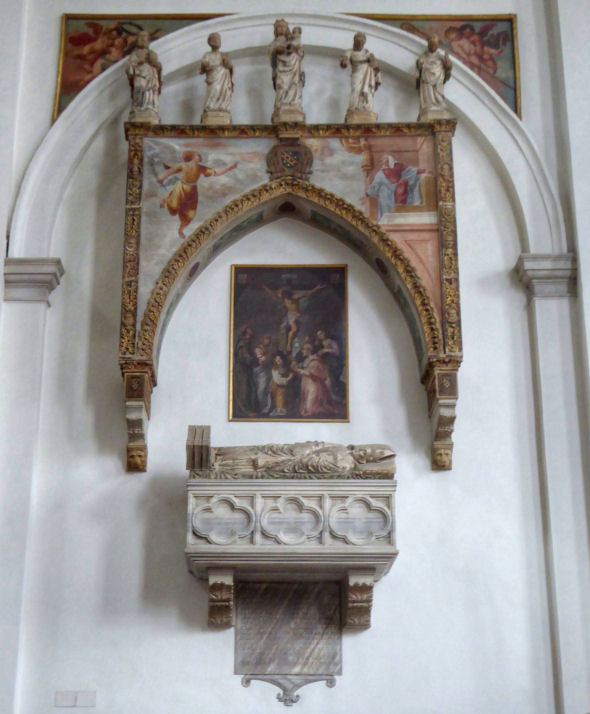 Art Art
No labels on the paintings and no guidebook available. The paintings in
here are all 18th-century or newer.
The second and third (deeper) chapels on the left have altarpieces by
Pietro Damini - Saint Jerome in the Desert with A Donor and a
Crucifixion with Mary Magdalene and Catherine of Alexandria. The
latter is the Chapel of Gregory Barbarigo, a 17th century Bishop of Padua,
who is himself lying behind a glass panel in the altar, which is the work
of Giorgio Massari. The row of dark bronze busts are of the patron saints
of Padua - Daniel, Justina, Anthony and Prosdocimo. The next chapel has an
unobjectionable Virgin and Child with Saints... with a curly-haired
baby John the Baptist, of 1716 by Gian Antonio Pellegrini.
The third chapel on the right has a dark and distant
Virgin and Child with Saints attributed to Padovanino.
Reports of paintings by Stefano dell'Azare, Tiepolo, and Paris Bordone
could not be confirmed. Ditto a
Virgin previously wrongly ascribed to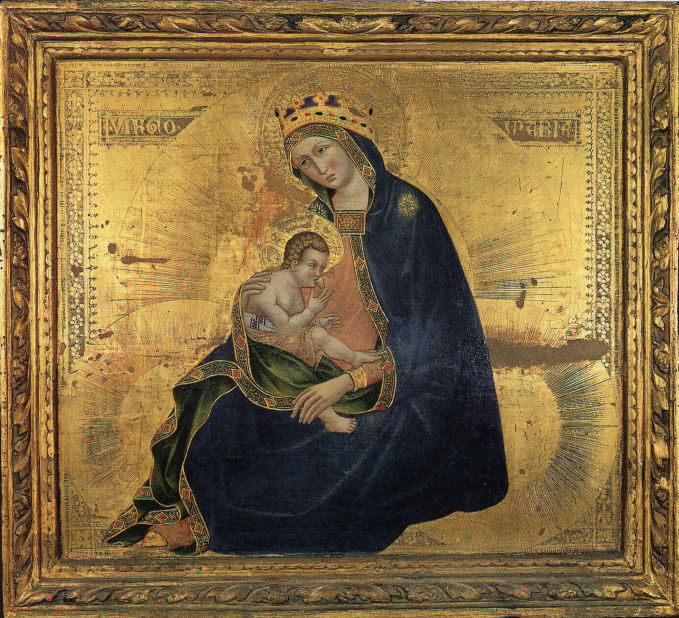 Giotto
- it was as a Giotto
that Petrarch bequeathed it to his friend Francesco da Carrara. Giotto
- it was as a Giotto
that Petrarch bequeathed it to his friend Francesco da Carrara.
A Byzantine-style Virgin and Child also mentioned might be the one
read about in reliable reports of a 17th-century copy of a late
13th-century Virgin and Child, documented as used every year in a
Christmas mystery play here.
I have since
also read about three works by Nicoletto Semitecolo in the sacristy here. Two
panels depict scenes from the Life of Saint Sebastian and one is a
Byzantine-looking gold-background Virgin and Child (see right).
The
transept has, as well as many tombs, a number of 18th-century-looking
canvases too high to see. As does the choir.
There are nasty melting-looking modern sculpture figures on the steps up
to the presbytery, which has carved walnut stalls by Filippo Parodi, a
pupil of Bernini who was also responsible for the very baroque reliquary
chapel in the Santo. Even the crypt is uninteresting.
Lost art
A sculpted bust of Bishop Stefano da Carrara of 1402 by an
anonymous sculptor is in the Eremitani Civic Museum.
The Epistolary of Giovanni da Gaibana, signed by the named
scribe in 1259 and made for the Duomo, is now in the Biblioteca Capitolare
in Padua. Padua was a leading centre for the production of illuminated
manuscripts in the mid-13th century, and the Byzantine-influenced style
known as Gaibanesque was very influential. |
|
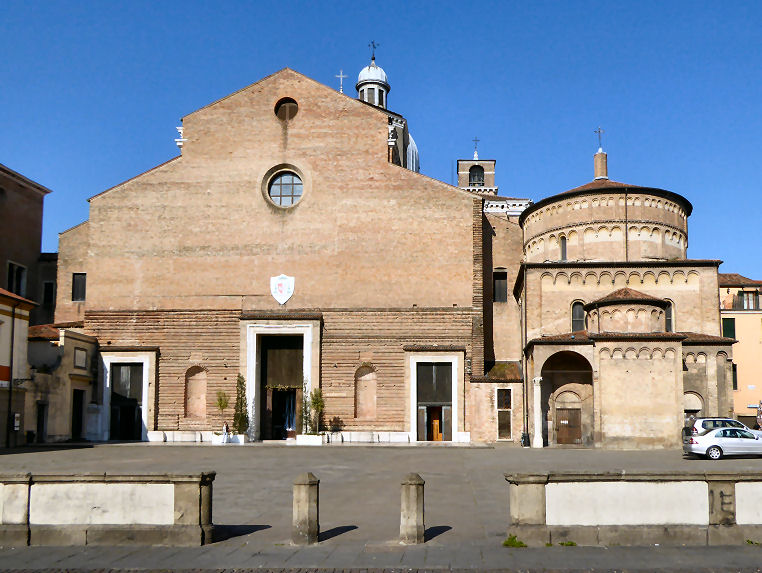
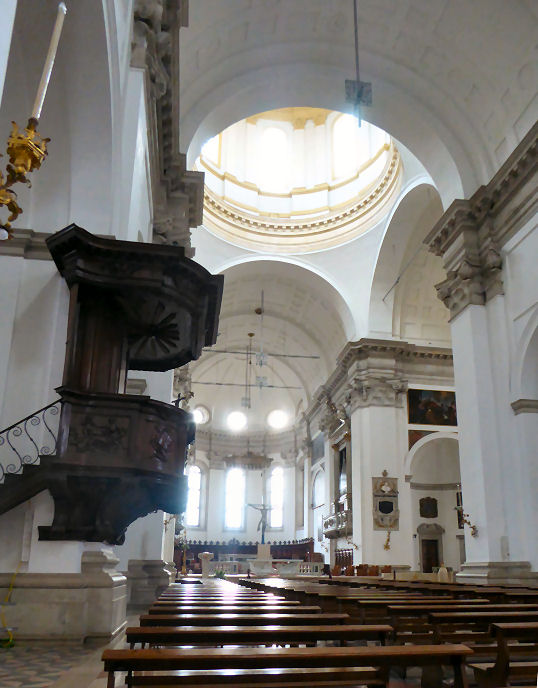
|
|
Opening times
Daily 7.30 - 7.30
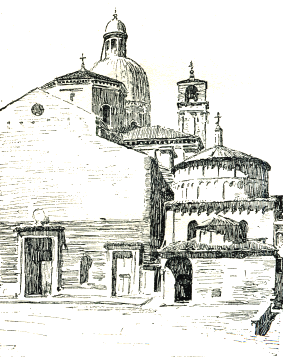
|
|
The Baptistery
|
|
History
Romanesque and brick and originally built around 1260. The interior was frescoed by the Florentine Giusto de' Menabuoi in the
mid-1370s,
the work commissioned by Fina Buzzacarini, the wife of
Francesco I da Carrara, the Carrara family having been
Giusto's best
patrons. Fina got Giusto to paint her and her three daughters as onlookers
to the birth of John the Baptist, the Crucifixion, the Way to Calvary and one of Christ's
miracles. The crowd in the latter also includes her husband and Petrarch.
Also appearing is Fina's sister Anna, the abbess of
San Benadetto, another church
which benefited from Fina's patronage. Husband and wife were buried here, in 1393 and 1378 respectively,
and the frescoes were finished by 1393.
Interior
The bust-length Christ Pantocrator is in
the centre (see right) surrounded by a heavenly kaleidoscope, in
five circles, of angels, patriarchs and matriarchs from the Old Testament,
and saints. Below Christ is the Virgin in the orant posture.
Beneath her the Creation of the World in the drum and beneath this
is the large Crucifixion, with the apse below it. Also in the drum, with its few randomly-spaced windows, there are
more scenes from
Genesis,
beginning with The
Creation. The pendentives have The Evangelists seated at desks,
each flanked by prophets. On the walls below scenes from the Life of John the Baptist
are on the south wall and
the Life and Passion of Christ make up the rest, ending with the
Pentecost in the dome of the apse.
Scenes from the Apocalypse line the walls of
the apse, over the entrance to which is The Crucifixion. The altarpiece
here, of The Virgin and
Child and Saints with Scenes from the Life of Saint John the Baptist (see
below)
is also the work of Giusto.
On the west wall opposite is the tomb canopy of Fina Buzzacarini
(see photo below right),
clearly modelled on those of the Carrara lords now in the
Ermitani church.
Her tomb chest, which almost certainly featured an effigy, and the epitaph are lost,
removed by the Venetians a few years after they conquered Padua in 1405,
along with Francesco's tomb. (Giusto was also buried in here.) In the fresco under the arch of the canopy Fina kneels to the
favoured right of the Virgin, is the same size as the holy figures, and is
unusually unaccompanied by her husband, which also makes the composition
asymmetrical. She is being presented by John the Baptist
and John the Evangelist who stand behind her. On the other side of the Virgin's
throne are local saints Daniel, with a model of the city, and Prosdocimus,
the first bishop of Padua who was renowned for the number of baptisms he
performed, and so appropriately mirrors John the Baptist's pose and
position on the left. In the space left by the removal of the tomb
chest and epitaph is a later full-length fresco of Saint John the Baptist
surrounded
by supplicants.
The interior was 'cruelly' repainted by Luca Brida in the 18th century but that work was reversed and
recent cleaning has left the frescoes looking fine. Damage to lower parts
of lower scenes, especially on the north wall, but still vivid colours on
upper levels.
The exterior was covered in frescos too,
but these have long since been washed away, although there is a small
fragment showing a woman's profile by Giusto in the Bishop's Palace.
Baptistery opening times
Daily 10.00 - 6.00
Closed Christmas, New Year’s Eve and Easter.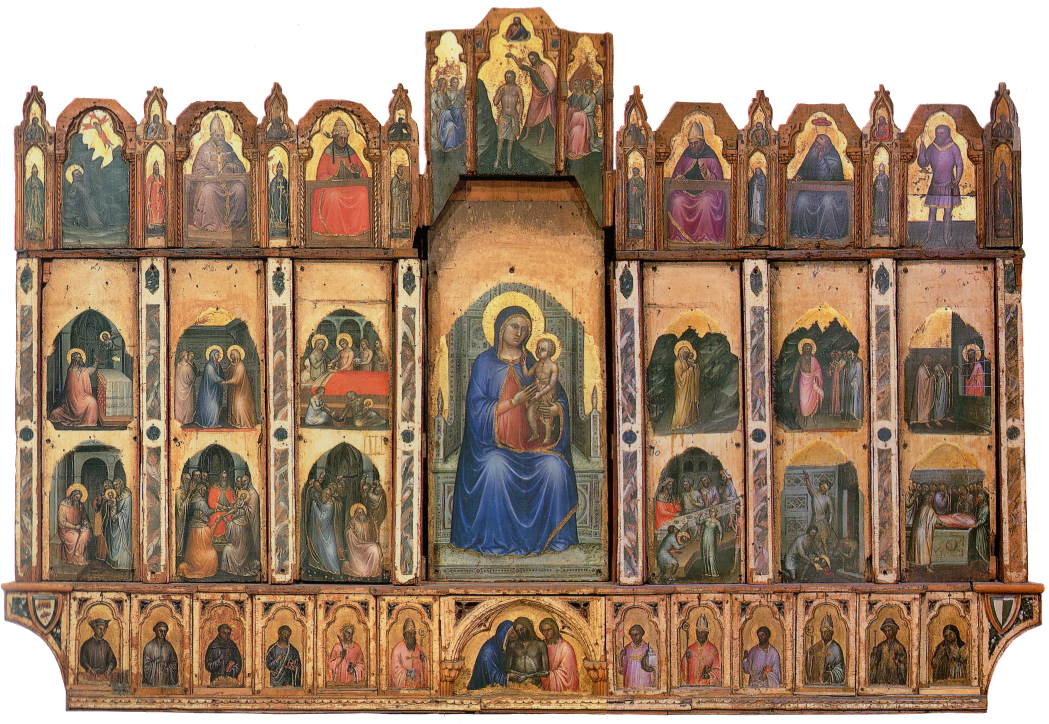
Bibliography
Anne Derbes Ritual, Gender & Narrative in Late Medieval
Italy
Fina Buzzacarini and the Baptistery of Padua' 2020
A big book, with a long title, concentrating on the influence on
the imagery in the baptistery of the religious and civic rituals enacted
there and the woman who commissioned the work. Investigating Fina's
influence informs the whole book, even the in-depth analysis of the
Biblical cycles, as does the perceived feminist agenda in the female-dominance
in the themes and figures.
|
|
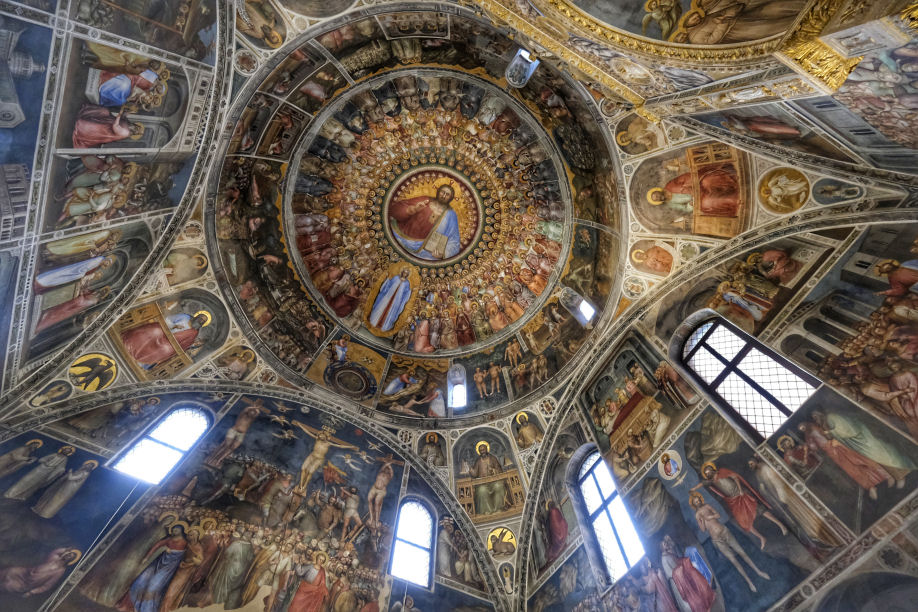
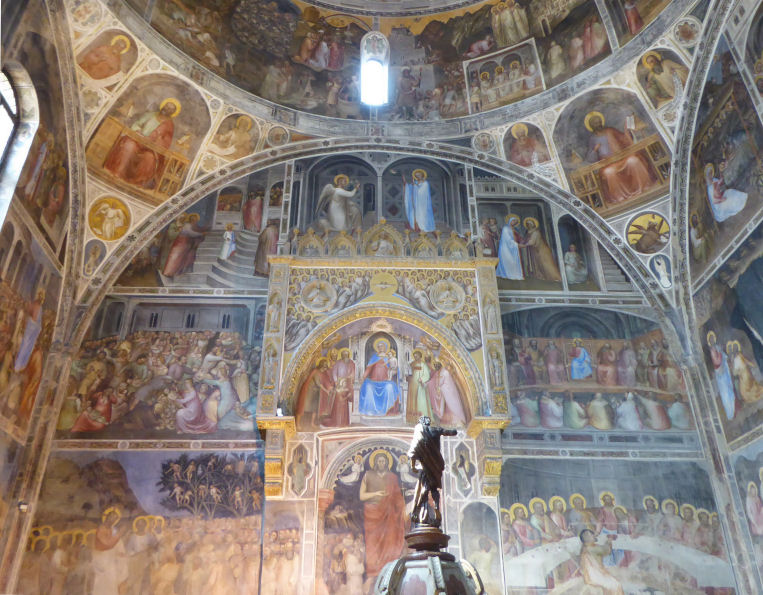
|
|
Beato Antonio Pellegrino
Oratory Church of St Anne
Via Beato Pellegrino |
|
Ognissanti
Via Ognissanti |
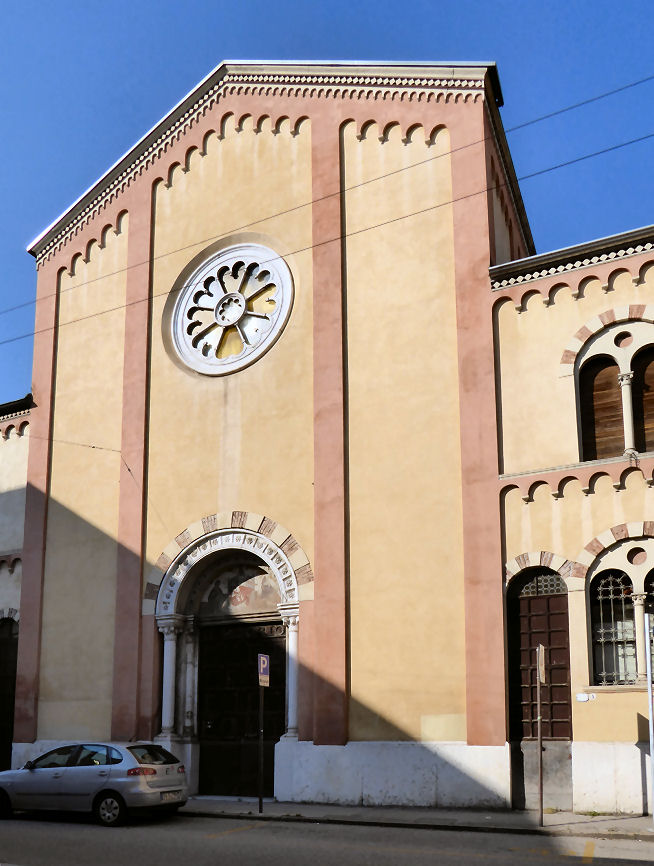
History
The church and convent were built by Benedictine nuns from Santa Maria
di Porciglia whose previous home had been destroyed by war in 1509 . They
brought with them the remains of beato Antonio Manzoni called
"Pellegrino". The complex was built to the designs of Vincenzo Dotto.
Following the Napoleonic suppressions and the expulsion of the
Benedictines the complex was used as a barracks and in 1838 made into a
hospice, undergoing major restoration in 1943 in a neo-Romanesque style.
The church is still part of the Shelter Home for the Elderly (IRA) and is
now officiated by the Romanian catholic community.
On the night of the 24th/25th of October 1993 several works of art were
stolen from this church. One of them, Christ at the Column,
attributed to Palma Giovane, was recovered in June 2014. In September 2017
there was much scaffolding and ongoing building work converting the
complex for use by the university.
|
|
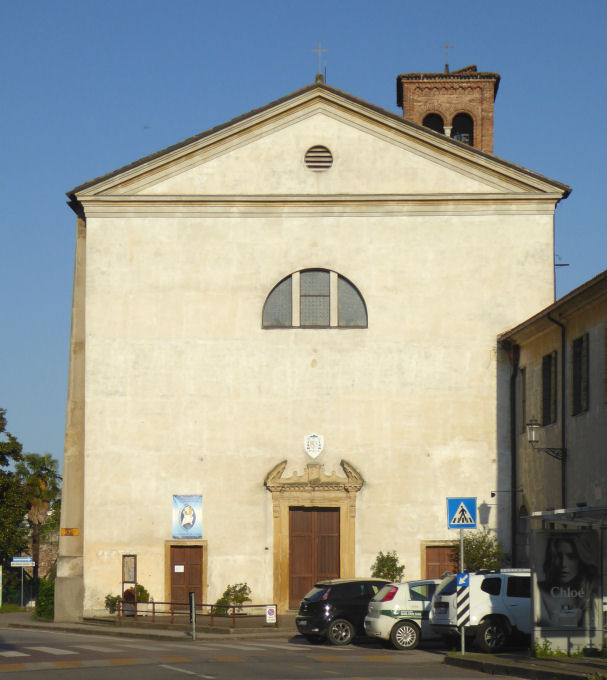 History History
Tradition puts a church here as early as the 4th century, but a documented
mention of a church built over a
necropolis is dated to the 9th March 1147, with monks from a Benedictine Monastery
officiating here from 1177. That complex had become seriously dilapidated by the 16th
century, but it wasn't until the years 1657-66 that the church was rebuilt
to an aisleless Latin cross plan to plans by Vincenzo Scamozzi. In 1671
Cardinal Gregorio Barbarigo found the church completed with five altars,
one housing the bodies of the martyr Saints Pauline and Valeria. In 1738
the building was enlarged towards the facade. With the Napoleonic
suppressions the church passed to the parish and the monastery abandoned
until it became a girls' boarding school in 1818. The bodies of Blessed
Pellegrino and Blessed Ongarello were brought here, but did little to
improve the church's popularity. The church was closed to worship is art
moved to the Immacolata church. Ognissanti reopened as a parish church on
July 5th 1941.
Interior
Contains three altarpieces from the 17th and 18th century and some early frescoes,
notably a fragment depicting Christ Pantocrator to the right of the high altar and a
Byzantine-style lunette.
Ruota degli
esposti
Inside the
doorway to the monastery, to the side of the church, is still to be found
a ruota degli esposti, a turntable in the wall for the depositing
of unwanted babies, which was still in use in the early 20th century.
Opening times
Just for services, it seems.
|
|
Eremitani
Piazza Eremitani |
|
this church now has its own page
|
|
Immacolata
Via Belzoni |
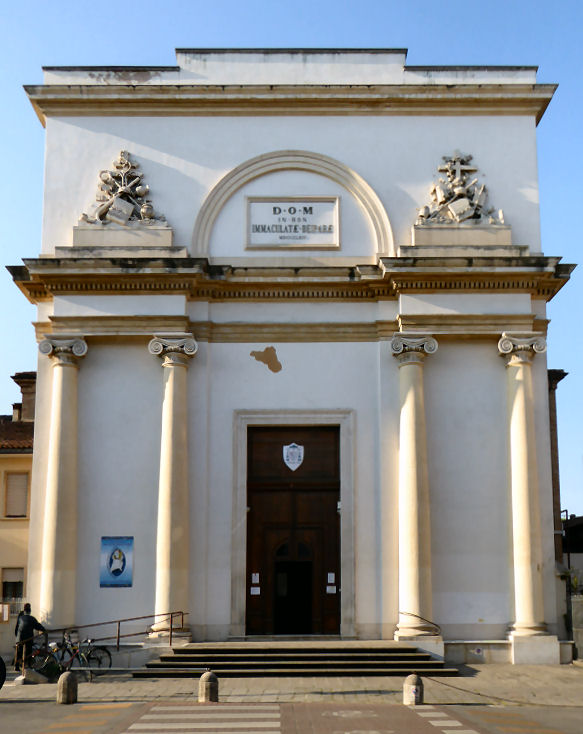 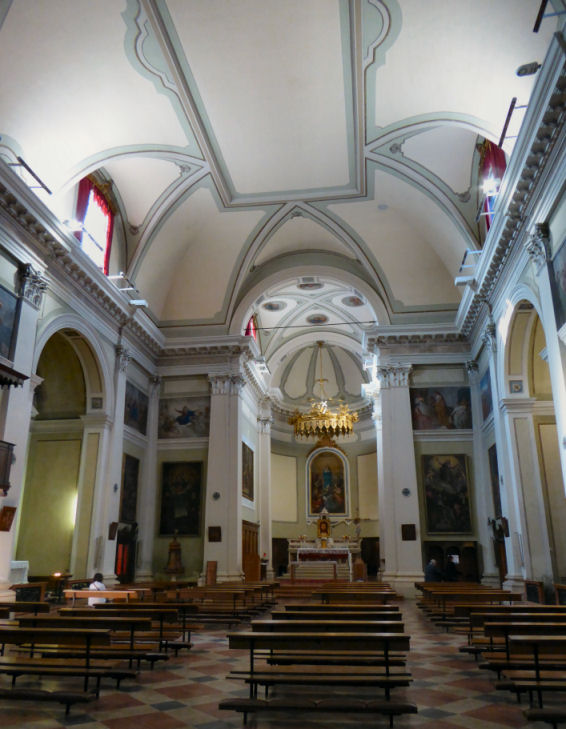
History
The Church of St Mary
Immaculate was designed by A. Tosini in 1853, being built over the site of
an earlier church called Santa Maria Iconia. The first documented mention
of this earlier church dates to 1165.
It became a Templar church and with the
order's suppression, a parish church for a little while, until 1312 when the
Knights of Malta (re?)acquired it until 1807, when it was bought by one Luigi Gaudio who converted
it for 'other uses'. It was demolished by 1834. The
unusual naming of the Virgin Iconia seems to derive from the word
cuneus, meaning a narrow plot of land by two rivers.
Interior
Contains much art from other churches, mostly the nearby Ognissanti,
including the Virgin of the Boatmen, a 15th century wooden statue, and
works by painter Gaspare Diziani - Job mocked by his wife, The
Killing of Agar, The Expulsion of Eliodoro, Gideon's Miracle, and
The Robe of St. Joseph shown to Jacob, Agar and Samuel. Also two
paintings by Francesco Maffei (Saint John in Patmos and a
Crucifixion from Ognissanti), an Assumption by Santo
Peranda, and an altarpiece depicting the Virgin and Saints Mauro and
Agnes by Bonifacio de 'Pitati.
Lost art
The earlier church had an Assumption with Apostles by Palma Giovane
over the high altar, a Baptism of Christ by Veronese (from San
Giovanni alle Navi) over the right hand one, and a Deposition by
Pietro Damini on the left.
|
|
San Benedetto Vecchio
Riviera San Benedetto |
|
History
Built in 1195 by Giordano
Forzaté for White Benedictines (so called because of their light-coloured
cowls). It initially housed men and women but arguments over the
management of finances led to the bishop splitting them up in 1259, with
the nuns remaining here and the monks moving to
San Benedetto Novello,
completed in 1262. The convent then flourished. Between 1356 and 1397 the
abbess was Orsola Buzzacarini, who took the name Anna when she became a
nun. She was the elder sister of Fina Buzzacarini, who was the wife of Francesco
I da Carrara (called il
Vecchio) and the commissioner of Giusto's frescoes in the
Baptistery. Anna embellished the convent much, with donations of
altarpieces and the like from her wealthy relatives, including many
endowments from Fina -
the construction and decoration of the
chapel of Saint Louis of Toulouse here being the most celebrated, gifts of
rich clothing and fabric the most common, paying for a wall to be built
the most prosaic.
Later Caterina Cornaro was
educated here, until the age of fourteen.
Much work from 1612, including a realignment and a new façade, at the
behest of abbess Aurora da Camposampiero, probably
as a result of the reforms of the Council of Trent. The old Romanesque
façade can still be seen at the west end.
The convent was
suppressed by Napoleon in 1810 and converted into a military barracks, the
church passing to parish use. Early 20th century restorations, but bombing on 11th March 1944
(the same raid by American bombers, targeting the marshalling yard, which
destroyed most of Mantegna's frescoes in the Eremitani) caused much
damage and destroyed many works of art, including the Apocalypse
cycle by Giusto de'Menabuoi and the chapel of Saint Louis of Toulouse,
rebuilt in 1952. There was also post-war restoration of the interior back to Romanesque style.
Giustiniana Wynne is buried here. She being
the Venetian-born daughter of an English duke and a writer, famous for her
friendships with Casanova and (more scandalously) Andrea Memmo. Her life
and affair with the latter being the subject of Andrea Di Robilant's book
A Venetian
Affair.
Exterior
The 18th-century façade has two bas reliefs of Saint Benedict, with statues of the
patron saints of Padua along the top.
Interior
Big, boxy and dark - there are small
clerestory windows on the left only - with plain brick walls and stout
pillars dividing the nave from the aisles. Pitched timber roof. Huge
well-populated baroque altar at the end of the choir, which is just a
continuation of the nave.
In the centre of right hand wall is an altar containing the remains of
Giordano Forzaté with an altarpiece celebrating him by Alessandro Varotari.
A putto in this painting carries a model of the church before the new
façade of the 17th century.
The door in the back wall leads to a chapel
frescoed in the 18th century which has a painting of Christ Among the
Saints by Domenico Tintoretto, the son. Works by Maganza, Minorello,
Balestra, Zanchi and Damini. Various frescoes by the door, including a 13th
century Romanesque one of The Deposition.
Lost art
In addition to the
Apocalypse cycle by Giusto de'Menabuoi the bombing on 11th March 1944
also destroyed the renaissance terracotta Deposition group in the
photo below. Only fragments remain in the Diocesan Museum.
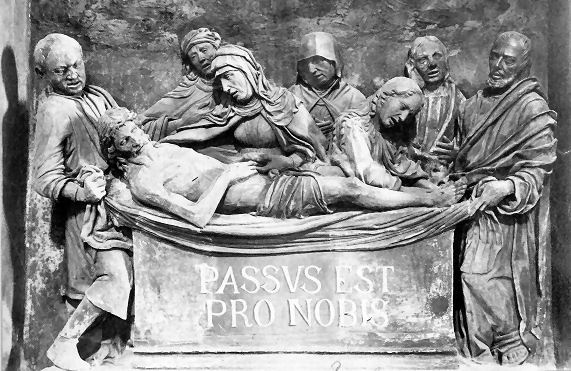
Famous legend
The stick which
Giordano Forzaté used to
mark out the boundaries of the monastery is said to have miraculously grown
into a tree when planted in what became the cloister adjoining the right
aisle of the church. It's fruit was said to cure fevers and it
supposedly reacted badly to deaths amongst the nuns and descendents of the
founder. After the suppression of the monastery the tree was transplanted
to the garden of the Palazzo Capodilista where it still thrives, we are
told.
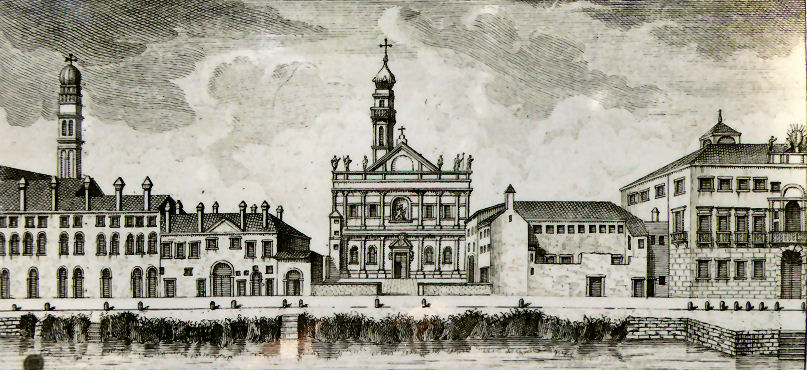
|
|
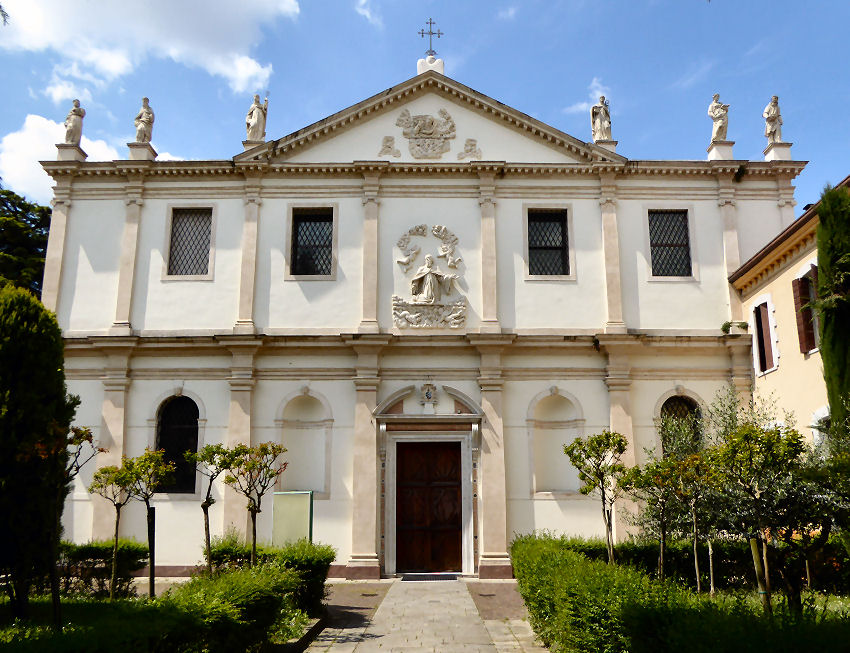
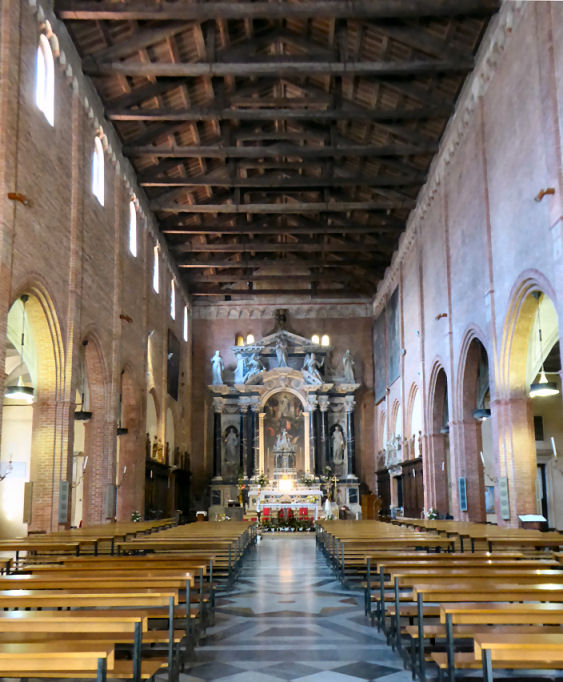
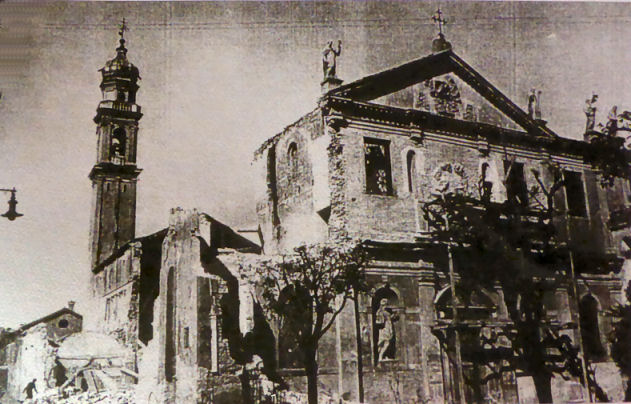
After the bombing of
March 11th 1944 |
|
San Benedetto Novello
Riviera San Benedetto |
|
San
Bonaventura delle Eremite
Via Alberto Cavalletto |

History
Monastery built by monks
moving from San Benedetto Vecchio in 1262 (see San Benedetto Vecchio entry
above).
Consecrated
on March 6th 1267. Went into decline in the 15th century. In 1441 Pope
Eugene IV gave it to another order, who improved it and in 1442 sold it to
the Olivetans who rebuilt the cloisters in 1504 and the church in 1567, to
designs by Francesco da Trevigi. The Olivetans thrived, until they were
expelled by the Venetian republic in 1797. Suppressed in 1810. Nuns moved
back in in the late 19th century, with the church being restored and
rededicated in 1894.
Lost art
Saint Frances of Rome Restores the Sight of a Girl by Palma Giovane
is in Eremitani Civic Museum. As is
Saint Bernard Tolomei Helps the Infected by Domenico Maria Canuti,
a Bolognese artist. And another one where the same saint helps the
demon-afflicted. They are the two surviving panels from a cycle depicting
the life of this saint created by the artist for this church between 1663
and 1664. |
|
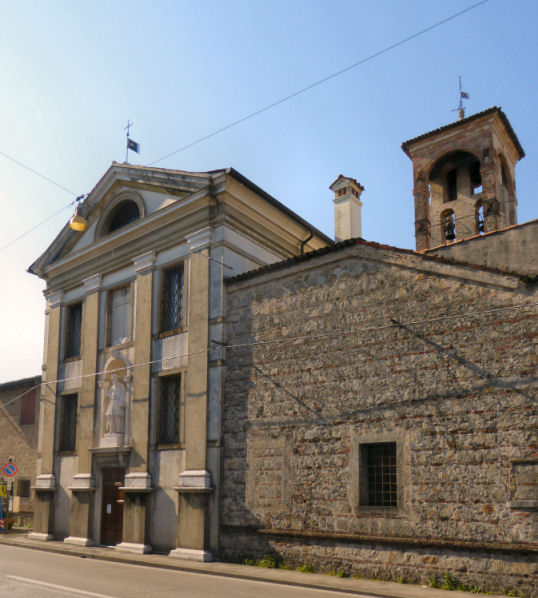 History History
Part of a complex built in the late 17th century. The order of the Virgin
Franciscan Hermits in Padua was founded on August 10th 1612 by Sister Graziosa Zechini and was first located in
the Pontecorvo area in three houses
donated by Lucia Noventa, a wealthy widow. In 1615 the
first chapel was built there. Noise and harassment, due to their proximity
to two taverns, resulted in the order moving here, onto land provided by
the patrician Malipiero family, purchased on February 26th 1680 with the
approval of the bishop Gregorio Barbarigo. The community moved here on
11th May 1682 , with the church completed later, the first mass being sung
on the 19th of March 1688. The complex survived the Napoleonic and Savoy
suppressions, with no electricity until
1985.
The church
Baroque
facade with four Doric pilasters supporting a pediment unusually
containing, we are told, a thermal window. Over the door is a niche
containing a statue of St. Bonaventure with the inscription SAN
BONAVENTURA / AN. DO. MDCXCIII / ANTONIO ZANINI DETTO MANGRANDA / FECIT DI
ANNI XVIII
Campanile
Odd in having a belfry of four high arches.
Interior
The seventeenth-century
interior is characterized by vertical momentum, we are told. Over the high
altar is St. Francis, St. Anthony, St. Bonaventure and St. Peter of
Alcantara by Gaspare Diziani . On the side altars, to the right a
Holy Family with Saints Zachary and Elizabeth by Pietro Damini, to the
left an Immacolata by the circle of Francesco Zanella.
Opening times
Online sources say hardly ever. A sign on the door said 3.30-6.00
every day, but it wasn't open when I passed in hope on evenings in May 2016 and
September 2017.
|
|
San Canziano
Piazza delle Erbe |
 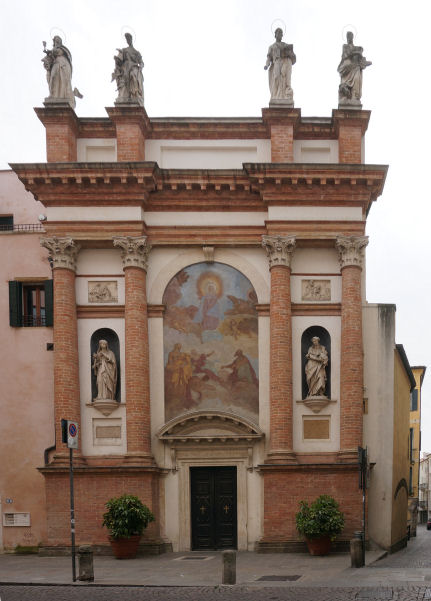
History
Named for Saints Cantius, Cantianus, and Cantianilla, the martyrs of
Aquileia, this church was already standing in 1034 as part of the monastery of Santo Stefano.
Damaged by earthquake in 1117 and fire in 1174. This original church with
three naves and an apse oriented to the east was rebuilt between 1595 and
1617, thanks to the legacy of Don Cesare Mantova, parish priest for 27
years. The completion of this work saw the presbytery now on the south
side and the construction of a new facade overlooking Piazza delle Erbe.
The church was finally consecrated on October 24th 1757 by Bishop
Alessandro Papafava. Restoration in 1955.
The church
Down the right side details and the rose window of the original facade
are visible. The current facade, once attributed to Palladio is now
thought to be the work of Vincenzo Dotto and Giambattista della Sala, The
niches between the two pairs of Corinthian semi-columns have statues of Purity and Humility by Antonio Bonazza.
Above are two 18th century bas-reliefs depicting the trial and martyrdom
of the church's name saints. On the attic level are statues of the four
Evangelists by Pietro Danieletti. In the middle of the façade is a
weather-damaged fresco of the Immaculate Conception by Guy Louis Vernansal.
Interior
A nave with a pair of aisles, or arguably an aisleless space with two
central side chapels each flanked by tapering functional spaces. Contains
works from the 17th century: terracotta statues of saints flanking the
altar in pairs of niches, by Paduan sculptor Andrea Riccio, including
Saints Anna, Cantianus, Cantianilla (or Agnes) and Jerome. Unstriking
paintings include The Procession of Carlo Borromeo by Giovanni
Battista Bissoni and Pietro Damini's The Miracle of Saint Anthony and the Miser's
Heart, in which the surgeon is a portrait of anatomist and surgeon
Girolamo Fabrici d'Acquapendente. The high altarpiece is a Virgin and
Saints attributed to Padovanino. These are
all mostly not well lit. Under the left hand altar, now dedicated to Saint
Rita, is a polychrome terracotta statue of the Dead Christ, another
work by
Andrea Riccio from 1530. His real name was Andrea Briosco, but he is
now known by his nickname Riccio, which means curly.
Lost art
Two polychrome terracotta busts depicting Mary Weeping from a
now-fragmentary 1530 Lamentation group by Andrea Riccio
are in the Eremetani Civic Museum.
Opening times
Monday to Saturday 7.30-13.30
Sunday 19.15-21.00
|
San Clemente
Piazza dei Signori |
|
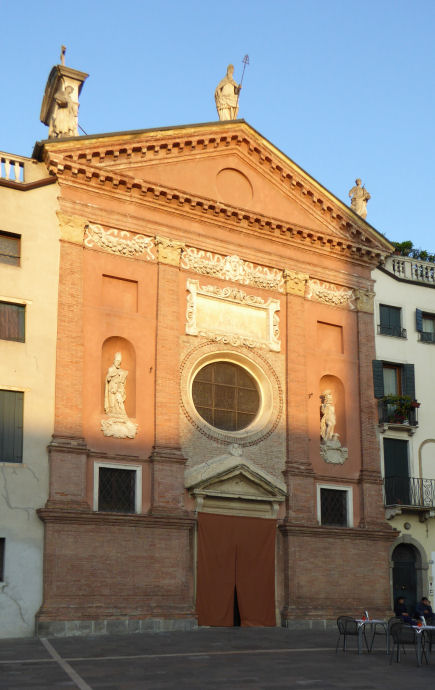
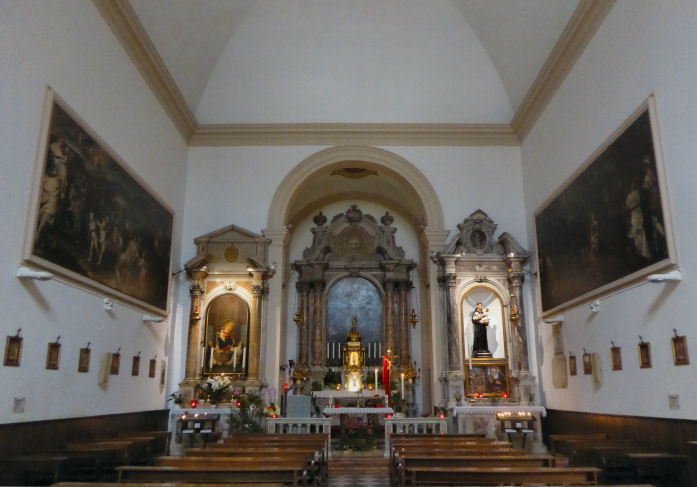 History History
A church on this site dates back to the end of the 12th century - a document of 1190
mentions its elevation to a parish church. It underwent much rebuilding in
the 16th century when the piazza outside was reorganised, and in the 17th and
18th centuries. It's the burial place of Tiziano
Minio, a famous Paduan sculptor.
Façade
Statues of Saints Giles and John the Baptist from
1696 in the niches, Daniel, Clement and Justina on the tympanum.
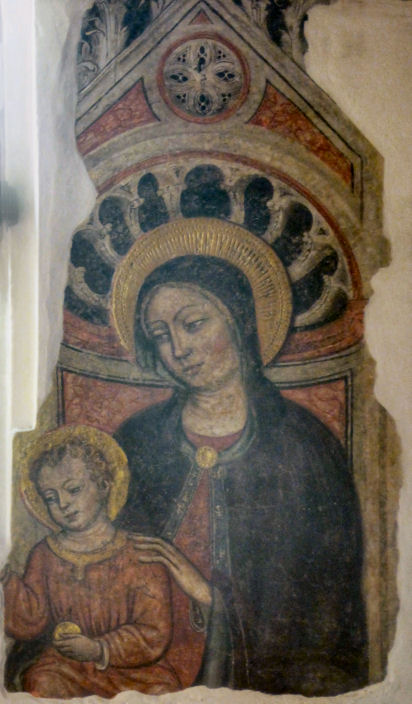
Interior
A single nave with a small square apse. Paintings of the 17th and 18th
century by
Giovanni Battista Bissoni, Pietro Damiani (Jesus Giving the Keys to Saint
Peter) Giulio Cirello (Prodigio dell'Acqua di San Clemente)
Pietro Malombra (Saint John the Baptist in Glory with Saints Carlo
Borromeo and Francis) and Luca Ferrari. The high altar (1782) has an altarpiece of
Pope Clement I (Saint Clement) Surrounded by Angels by Luca Ferrari. The
Altar of St Anthony erected by the Guild of
Grocers (The Fratelea Casolinorum) has a bas relief of Saint John the Baptist holding the tools of their trade.
The fresco fragment of The Virgin and Child (see right)
on rear wall under organ gallery near the entrance is attributed to Jacopo Bellini.
Lost art
A damaged sculpted panel of the Miracalo di Sant'Alò by
Nicolò Baroncelli is in the Eremitani Civic Museum.
Opening times
9.00-1200, 4.00-6.00
supposedly, but I have only found it open once in
three years/tries.
|
|
San Daniele
Via Umberto I |
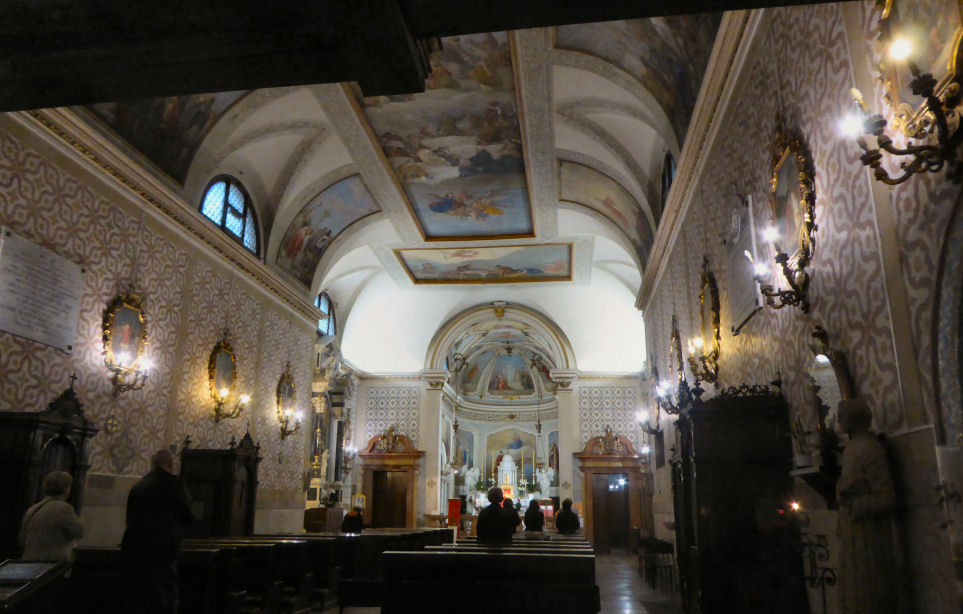 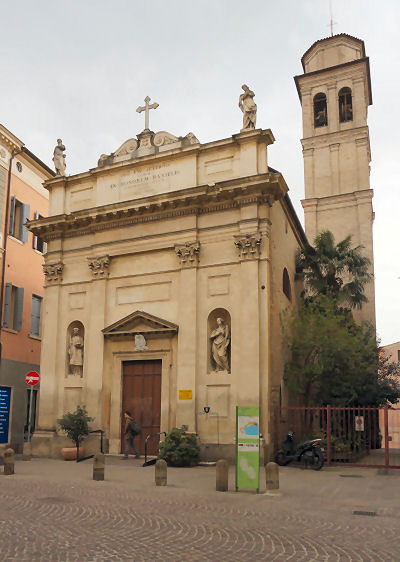
History
A church and monastery were built in 1076. Legend has it that when the body of Saint
Daniel, the early Christian martyr and one of Padua's patron saints, was
bring translated from the church of Santa Giustina to the Cathedral when
they got here the relics became too heavy to carry, with a darkness and
thunder and lightning to force home the point, so the bishop built a
church here to house them. Not much of this original
chapel remains as it was almost completely rebuilt in the 18th century in
late-Baroque style by Francesco Muttoni with more work on the façade and
interior, neo-classical this time, in the 19th century. In 1771 the
monastery was suppressed and became a private residence, but in 1948
Benedictine monks, exiled from a monastery in the former Yugoslavia, came
here.
Façade
The façade is by Agostini Rinaldi with statues of local Saints Daniel and
Justina,
by Francesco Rizzi, in the niches.
Interior
Hall-like with an organ loft over the entrance. The shape of the apse
derives from the romanesque church. The ceiling has 19th
century Scenes From the Life of Saint Daniel by Sebastiano Santi. A
Nativity altarpiece by Palma Giovane is reported.
The
Paduan illuminator Benedetto Bordon (c.1455-1530) is buried here.
Lost art
A 1795 guide to Padua by Pietro
Brandolese mentions the first altarpiece on the left as depicting
St Charles Ministering to Plague Victims by Giovanni Battista
Bissoni, and an altarpiece on the right having a canvas depicting The
Crucifixion with the Virgin and Saint John the Baptist by Francesco
Zanella.

|
|
San Francesco Grande
Via San Francesco |
History
Designated as Grande to avoid confusion with the church of San Francesco
Piccolo, a church demolished by the 16th century, this church was built by Baldo Bonafario of Piombino and his wife Sibilla de Catto, along with
a convent hospital, for the Franciscans. Work began in
1414 led by builder Nicholas Gobbo. In 1417 the church was built and work
continued until mid-century. After the death of Bonafario the work
was completed by his wife. This church was a single nave with chapels on
the left and was consecrated on October 24th 1430. Due to the growing
popularity of the Observant Friars Minori the church and monastery were enlarged at
the beginning of the 16th century, under the direction of architect Lorenzo Pardi da Bologna.
The chapels on the right were built and and the transept enlarged. The
monastery was enlarged too, with a second cloister added. Fresco lunettes in the style of Squarcione
in the loggia on the façade are very faded but were recently restored.
Baldo and his wife Sibilla were buried here, as were Ferdinando Carlo
Gonzaga-Nevers, the last Duke of Mantua, and Francesco Squarcione, a
painter more famous for his pupils, including Mantegna, Zoppo and Crivelli,
than his own talents.
Suppressed in April 1810, becoming a parish church in the same
year. In 1862 the floor was re-laid at the expense of many old tombstones.
Total restoration in 1873. In 1914 the Franciscans returned to the church
and part of the old convent.
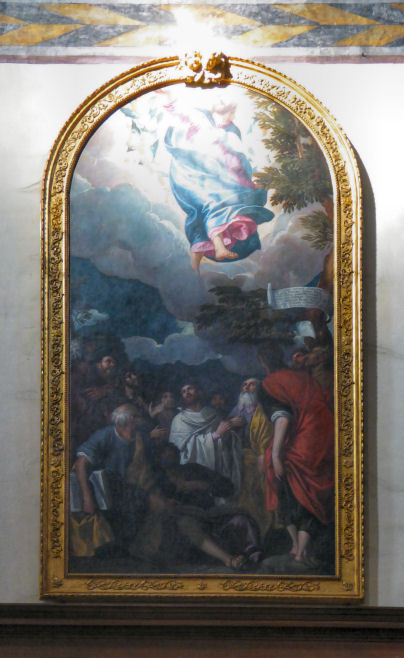
Interior
Four side chapels each side of the wide nave with wide aisles, the transept not much
deeper than the chapels but the right hand chapels are deeper and the
right hand transept arm is marble-fenced off to enclose a red and
white marble baroque extravagance by Giuseppe Sardi, built 1655/70.
A long choir with an
arch-shaped fresco of The Annunciation over the arch (see
below right).
The second chapel on the right is impressively frescoed inside
(see below) and into the vault and over the arches of the
aisle space in front,
in 1523 by Girolamo dal Santo.
An Ascension by Paolo Veronese originally to be found in the marble frame
in the left transept chapel is now on the entrance wall high over the door
(see right). The lower part with the Apostles was added in March 1625 by Pietro Damini
after this part of the original was chopped off and stolen. The
inscription inserted at the Fathers' request speaks of a 'nefarious theft
from the highly wrought painting of the excellent Paolo Veronese' being
restored by 'the felicitous pencil of Pietro Damino'. The Twelve
Apostles in Prague's Olomouc Gallery is now thought to be the lost
lower part. The parts were exhibited together at the Veronese e Padova exhibition
in Padua in 2014. But another Assumption, in Dijon, is also a
candidate for the top of the Prague painting, which they call Eleven
Apostles.
 |
|
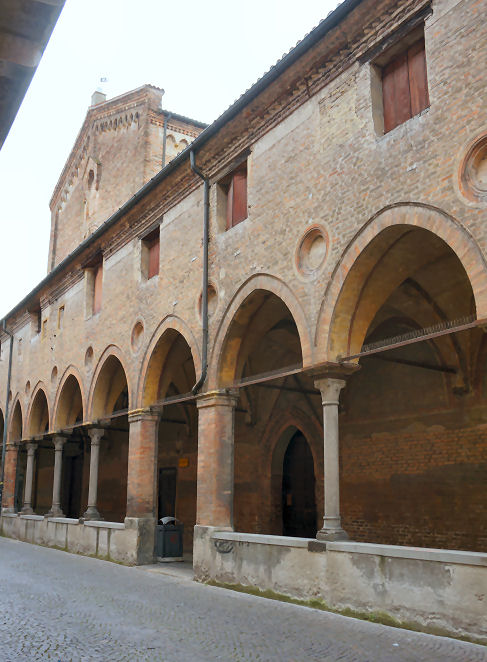
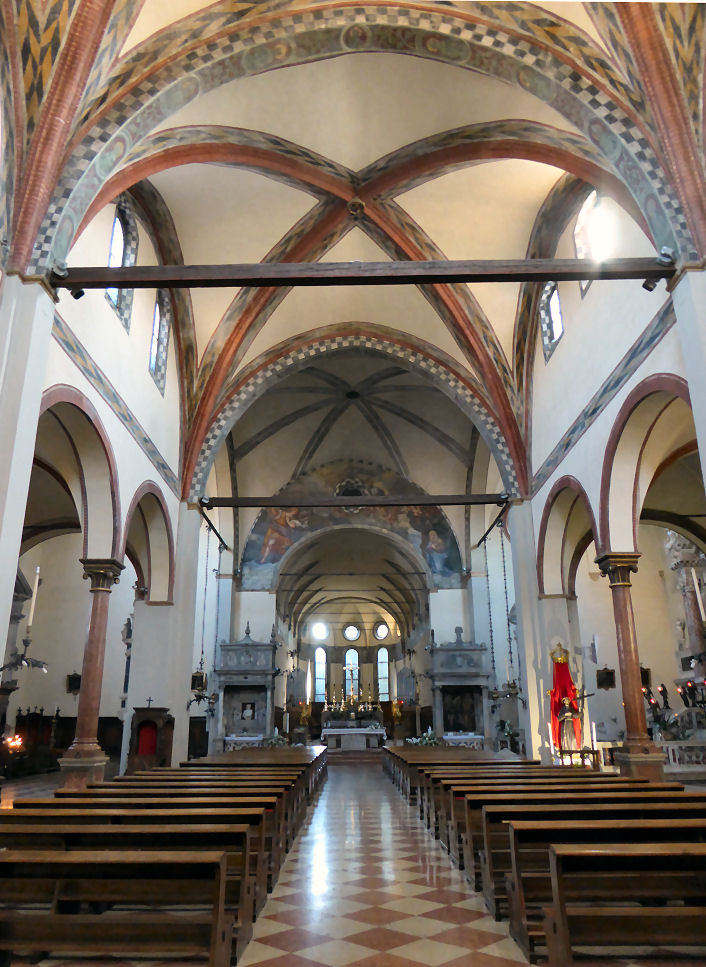
|
|
The Scuola della Carità
|
History
Opposite San Francesco Grande, this scuola was founded in 1414 for a lay confraternity, also using
bequests from Baldo Bonafario and his wife Sibilla.
Interior
The scuola houses
a cycle of 12 fresco panels of episodes from
The Life of the Virgin made by Dario Varotari in 1579. It's an unusual
sequence in that it avoids the usual scenes involving the life of Jesus.
The panel in the photo (right)
is the rarely-seen Death of Saint Joseph, a subject which became
more popular in the 17th century.
Opened by volunteers from Salvalarte, who don't have a website but are a
branch of Legambiente.
Scuola
Opening times
Thu & Sat 10.00-12.00
Thu-Sat 4.00-6.00*
(*May-October 4.30-6.30)
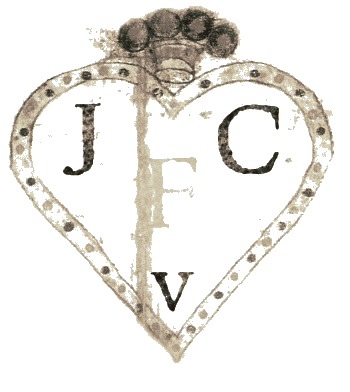 |
|
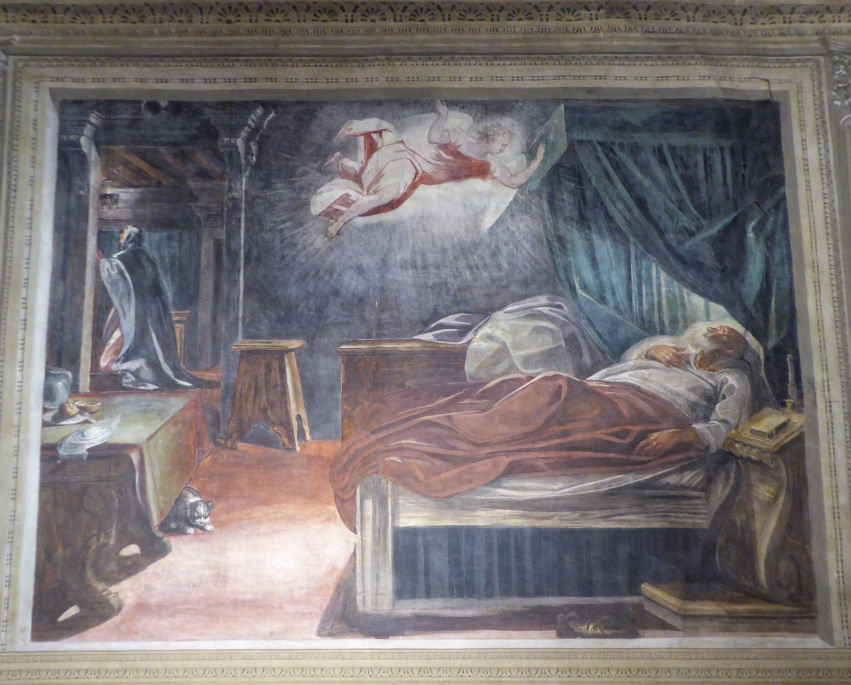
|
|
San Gaetano
Via Altinate |
History
Also
known as Santi Simone e Giuda this church was built from 1582 to 1586 by Vincenzo
Scamozzi for the Theatines, an order founded by Saint Cajetan of Thiene, on the site of an
old church called Saint Francesco Piccolo run by the Umiliati from whom
the convent complex had passed when their order was suppressed by the Pope in 1571.
Between 1578 and 1581 the Theatines had bought up more property, with the help
of Bishop Federico Cornaro and with money from Alvise Cornaro. But
the expansion work from 1629 failed to respect Scamozzi's plans, and baroque
enrichments carried out at the behest of provost Raffaele Savonarola
between 1692 and 1730 did not find universal approval. This work involved
marble enrichments, three new altars and mannerist paintings. Suppressed
by Napoleon in 1810, part of the monastery became the Palace of Justice in
1844 and the church became a parish church. Restoration in the 19th
century. A fire which almost destroyed the monastery in 1929 left the
church undamaged.
The monastery is now a museum.
Interior
This was the first
centrally-planned church built in Padua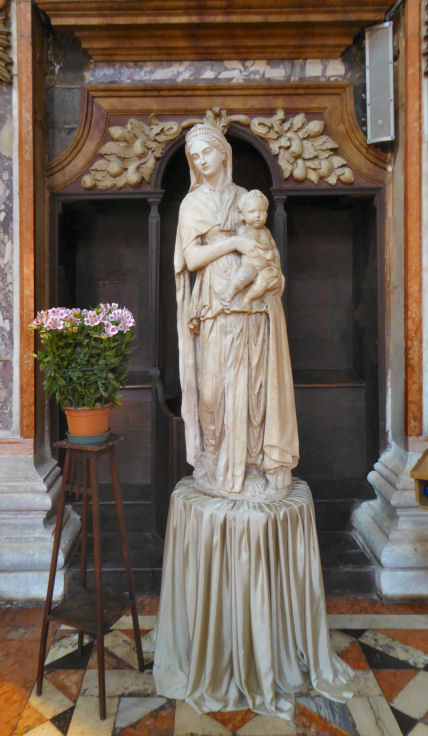 . Inside it's aisleless tall and octagonal (or maybe
square with the corners chopped off) and decorated with the marble panels
and stucco typical of the 18th century. Sharp left as you enter, and down
some stairs, is the unserene Chapel of the Holy Sepulchre. The small Presbytery and separate
choir beyond are all marble and stucco too, but the large sacristy is much
plainer and more solemn. . Inside it's aisleless tall and octagonal (or maybe
square with the corners chopped off) and decorated with the marble panels
and stucco typical of the 18th century. Sharp left as you enter, and down
some stairs, is the unserene Chapel of the Holy Sepulchre. The small Presbytery and separate
choir beyond are all marble and stucco too, but the large sacristy is much
plainer and more solemn.
Art highlights
The dome has sixteen radiating trompe l'oeil fresco panels of Paradise
by Parisian painter Guy-Louis Vernansal. Paintings include an oddly bright
Deposition/Mourning by Varotari.
A subtly mobile statue of the Virgin and Child
is a survival from the Umiliati church by the Paduan sculptor Andrea
Riccio (1470-1534) (see right). His real name was Andrea Briosco,
but his nickname, Riccio, means curly.
Two side chapels the right-hand
one has The Transfiguration by Pietro Damini, The Presentation
at the Temple of 1610 by Palma Giovane, is in the left-hand one.
There's San Carlo Borromeo
Saving a Child by Pietro Damini and works by Jacopo Bassano, Alessandro
Maganza and GB Bissoni. There's an altarpiece by Vernansal too, depicting
The Flagellation, in the Chapel of the Holy Sepulchre.
Opening times
9.00-12.00, 4.00-6.00
|
|
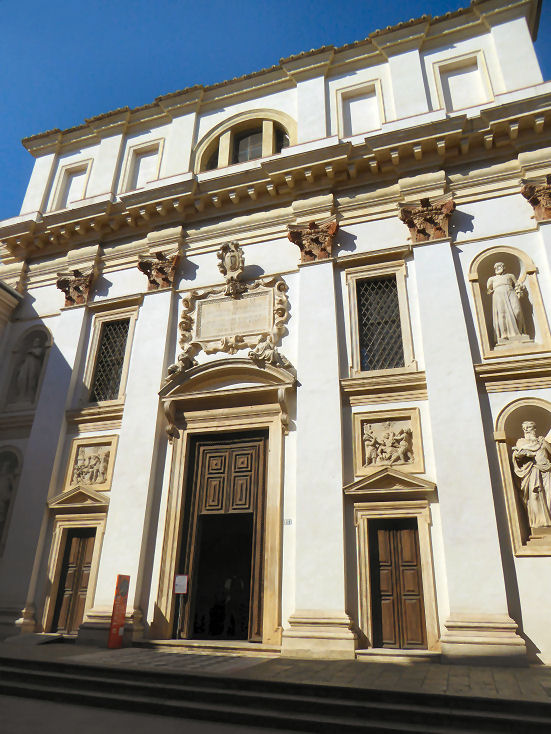
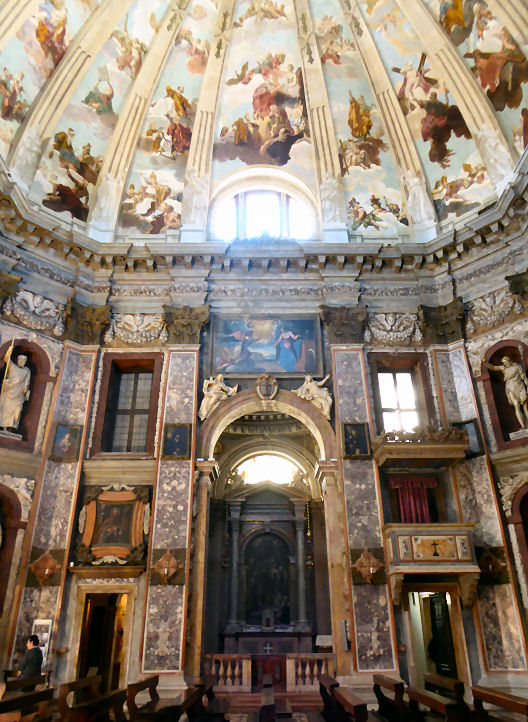
|
|
San Giovanni di Verdara
Via San Giovanni di Verdara |
History
The church of a monastery built in the early13th century by Benedictine
monks, in an area know for the lushness of its vegetation, hence the
name. In 1431 Pope Eugene IV gave the complex to his nephew Cardinal
Antonio Correr , bishop of Ostia, who entrusted it in 1436 to a community
of Lateran Canons who undertook a campaign of restoration and enlargement,
entrusting the work to Lorenzo da Bologna and Giuliano da Porlezza. From
the 15th to the 17th century the canons collected art and books, amassing a
library that attracted the likes of Pietro Bembo. The collection of Marco Mantova
Benavides, a renowned 16th century humanist, jurist and collector who is
buried in the Ermitani, came here in 1711. In 1783 the Venetian Republic
abolished the order of the Lateran Canons. The art went to the civic
museum and the books to the Marciana Library. The church remained in use
with the monastery serving as an orphanage, an Austrian barracks in 1847.
The church was last used by Jesuits in 1866, and the complex now houses
the Military Department of Forensic Medicine of Padua, the church remaining as a neglected and
inaccessible wreck.
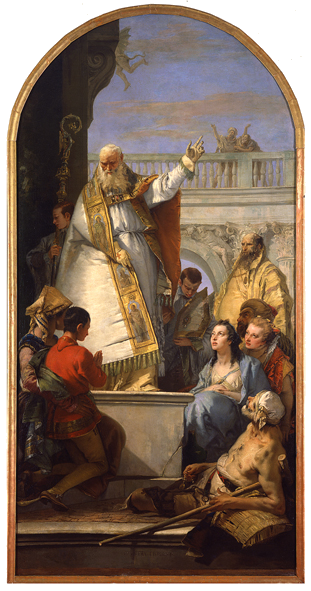
People buried in the church: sculptor Andrea Briosco, humanist and writer
Lazarus Bonamico, Calfurnio Giovanni, medallist Giovanni da Cavino,
painter Luca Ferrari, and Domenico Senno.
Exterior
Has a largely 14th/15th century Gothic facade with a large rose window and
later embellishments. On the arch above the main door was a fresco by Giacomo Ceruti of the Virgin with Saints Joseph and John,
while to the left was the tomb of Andrea Briosco bearing the artist's
effigy, dispersed after 1797. To the south are a pair of large cloisters.
Interior
A nave and two aisles.
Lost art
A 1622 Wedding at Cana by Padovanino,
now in the Chapter Hall of
The Scuola di San Marco in Venice.
On the altar of St. Patrick, the first on the
left, was Giambattista Tiepolo's Miracle of Saint Patrick of 1745/6 now at
the Eremitani Civic Museum. There they used to call it Saint Paulinus of Aquileia, and
there was controversy over whether it depicts the Bishop of Ireland or the
latter
more local, if obscure, saint. The Lateran Canons' particular devotion to
Saint Patrick was cited. Now the caption says it's Saint Patrick Bishop
of Ireland. Two works by Pietro Rotari where commissioned at the same
time.
Also there from here is a late Supper at Emmaus by
Giambattista Piazzetta and a large Crucifixion panel by Stefano dell'Azare.
|
|

|
|
San Luca Evangelista
Via XX Settembre |
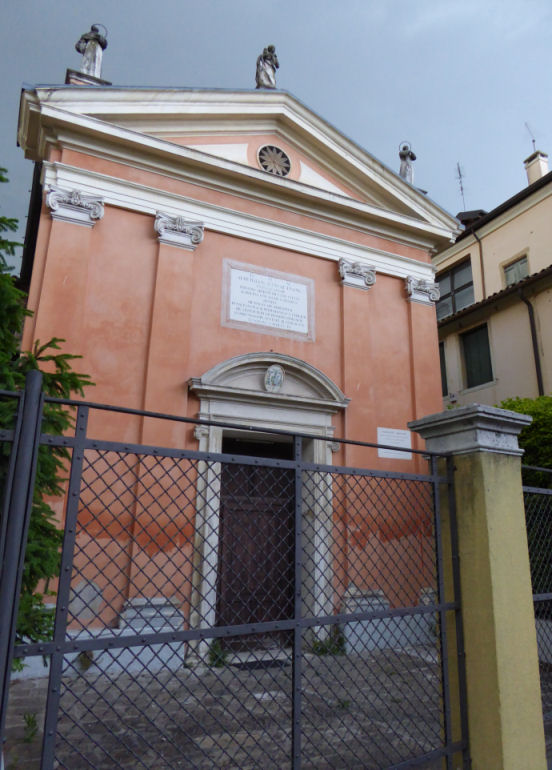
History
A church dedicated to the Twelve Apostles was built in 1174, replacing an older building
which had been demolished to make way for the city walls. This building was
itself demolished by order of James I of Carrara in 1320, after which construction of the current church
began, consecrated on
the 18th of
October 1381. In the 17th and 18th century rebuilding altered the original
east-west orientation. Suppressed in 1807 by Napoleon, on July 2nd 1815 the church was reopened as
part of the new parish of Santa Maria dei Servi. It is currently used by
the Greek-catholic community.
The church was the seat of the Confraternita
dei Pittori.
On May 6th 1655 Bartolomeo Cristofori was baptized here, he being the
inventor of the piano.
The church
The building is now oriented north-south, but you can still read the
original east-west orientation of the external walls. The simple baroque facade,
with two Ionic pilasters on each side, overlooks a fenced area which used
to be a cemetery. The facade is topped with statues of the Virgin (at
the top) St. Anthony (left) and St. Francis (right). On the wall are two plaques.
One commemorates the reopening of the church in 1815, the
other the baptism here of Bartolomeo Cristofori .
Interior
The below is all what I've read, not what I've seen.
A Greek cross, the only one so shaped remaining in Padua. The
side chapels were added in 1834. To the left, there was a painting of Sant'Espedito Martyr,
which was stolen in 1997 and now replaced by a photo.
Over the baroque 18th century altar in
the chapel on the left is a 14th century fresco of The Virgin and
Child, rediscovered during rebuilding in 1778 and restored by
Francesco Zanon, and again restored in 1998, previously described as "in
the manner of Giotto" and now attributed to Giusto de 'Menabuoi.
Worryingly it is reported that the figures
were crowned with silver tiaras donated in 1995.
Further along on the left is a Pieta attributed to Bartolomeo Montagna.
In the north transept is a 17th century painting of the Veronese school
showing depicting Saint Benedict Handing his Monastic Rule to Saint
Augustine.
The marble high marble altar, decorated
with semiprecious stones, is by Francesco Corbarelli and dates to 1667-68.
The decoration and art here is all 17th century. The high altarpiece by Pietro Damini San Luca
of The Virgin and the Patron Saints of
Padua in which the Torlonga
is also depicted. |
|
San
Michele
Oratory -
Piazzetta San Michele |
History
The original church here may date back to the 6th or 7th
century,
being dedicated to the Archangels. Or it could be later as the first
documented mention dates to 970. The Carrara lords helped in its
rebuilding after a fire in 1390, which was caused by fighting between
Francesco Novello's Paduans and Milanese soldiers, sent by the Visconti,
who had besieged the nearby castle. This work, which involved expansion
and painted decoration, was finished in 1397. In 1497 it passed to the
congregation of Santo Spirito in Venice, in whose hands it remained until
suppressed by the Pope Alexander VII in 1656. The Venetian Republic sold
of its assets to pay for its war against the Ottoman Empire. After
becoming the property of the Patriarch of Aquila the church went through
the hands of various Venetian families in the 16th and 17th centuries. In
1792 much of the contents and art were removed, in 1808 it ceased to be
the parish church and in 1812 it was closed. In 1815 Francesco Pisani, who
lived in the palazzo next door, decided to demolish the church. All that
was left was part of the nave and the chapel dedicated to the Virgin,
which took on its present name at this time.
Andrea Palladio was baptised in this church in 1508.
Interior
The current small space, once the chapel mentioned above, is full of
vivid frescoes by Jacopo da Verona, a pupil of Altichiero. They were painted in
1397 and depict the Life of the Virgin, having been
commissioned by Pietro de' Bovi, an official of the Ferrarasi mint.
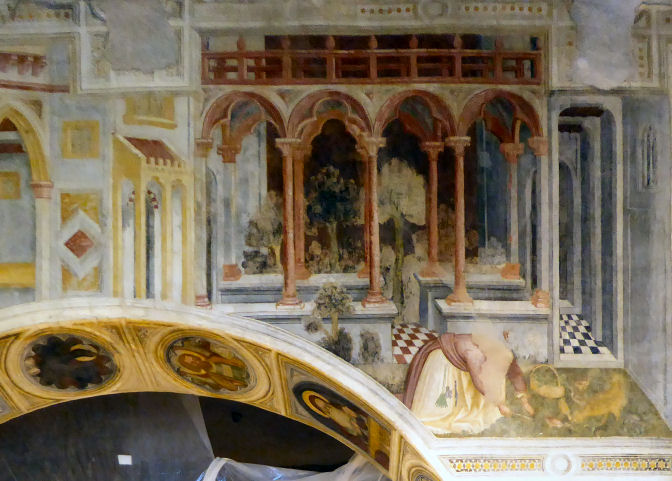
Opposite the entrance, above the arch into the nave of the church, is a
three-panelled Annunciation. Below is Saint Michael, weighing
the souls of the dead, and The Banishment of Adam and Eve, possibly
a 16th century addition.
On the left wall are a Nativity and The Adoration of the Magi,
the latter containing portraits of the Carrara lords Francesco il
Vecchio, Francesco Novello and Francesco III as the first, second and
third magi. Higher up to the right the Torlonga is depicted, it being one of the
towers of the old castle before its 18th century transformation into an
observatory.
The right wall has The Funeral of the Virgin and The Pentecost
(see right), the former panel containing portraits of the
commissioners of the frescoes, to the right dressed in dark robes. The wall of the
current entrance has a very damaged Ascension. Under the arch, into
what's left of the church, are The Doctors of the Church and The
Four Evangelists. Some of the 16th century frescoes which decorated
the nave remain, including a Deposition and a St Paul, attributed to
Stefan dell'Azare and Domenico Campagnola respectively. When I visited
in May 2016 this area was being restored, or maybe rebuilt.
Lost art
A large damaged fresco fragment of the Virgin of Humility
with Saints James and Anthony Abbot probably by Cennino Cennini from
around 1398/1400, now in the Eremitani Civic Museum, is said to have come
from the vicinity of this oratory.
Opening hours
Tuesday-Friday 10:00 - 13:00
Saturday and Sunday 16:00 - 19:00 June to September
15: 00-18: 00 October to May
Entry: full price €3.00, reductions €2.50
Run by the the
Torlonga
association who also run the Specola Museum over the river.
|
|
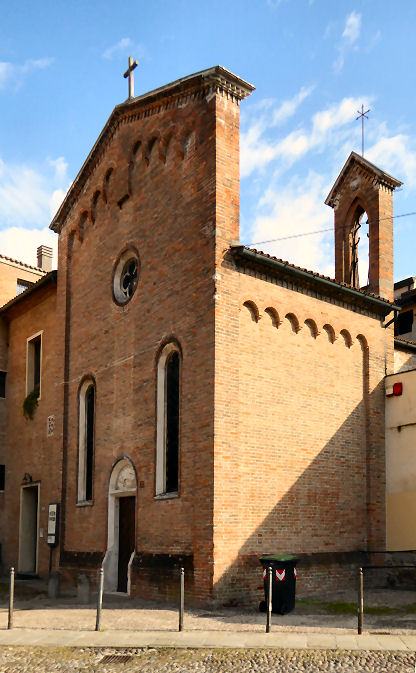
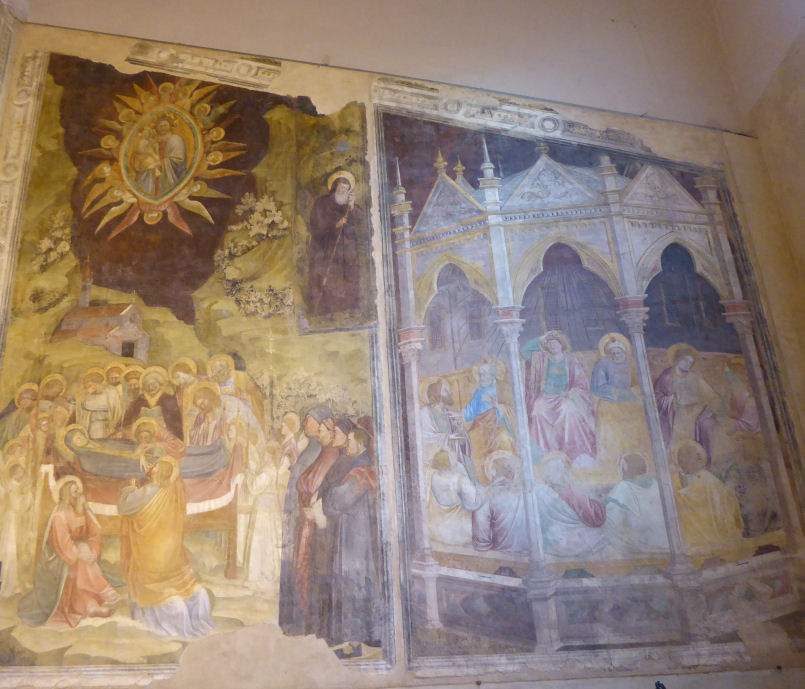
|
|
San Nicolò
Via San Nicolò |
|
History
Original church built 1090 by Bishop Milo. The oldest parts of the
current church are the door and the columns near it, from the 14th
century rebuilding. The rest is much later, 17th and 18th century, but
retains an ancient feel.
This may be because the church underwent much restoration in the
1960s/70s laudably aiming to restore it to it's pre-baroque state.
Exterior
The area in front of the church was a cemetery before Napoleon. The
asymmetry of the interior is reflected in the facade view, with the
Forzatè chapel poking out to the right of the campanile. Over the 15th
century doorway is a sculpted figure of Saint Nicholas, with God above and
an Annunciation to the sides.
Interior
Has Padua's common alternating columns-and-pillars thing separating the nave from a
narrow aisle on the left and an aisle and three connected deep chapels on
right.
A large and Giottoish 14th-century fresco fragment dominates the
beginning of the left aisle depicting The Crucifixion with scenes
from The Life of John the Baptist above (see below right). These are by Gerardino da
Reggio and commissioned in 1374 by Marcus Forzatè, whose family chapel is
opposite. There is a very damaged frescoed vault above with four roundels
probably of the Four Evangelists.
The decorated ceiling in the shallow chapel
to the left of the choir depicts Saint Liberalis and is said to be by Jacopo da Montagnana
(Jacopo Parisato) a pupil of Mantegna. The high altar was converted from
the old Baroque altar table. The choir
semi-dome is frescoed and there's an Annunciation frescoed over the
right-hand chapel.
Of the right hand chapels the furthest, the
organ chapel, has Il Compiano by Varotari.
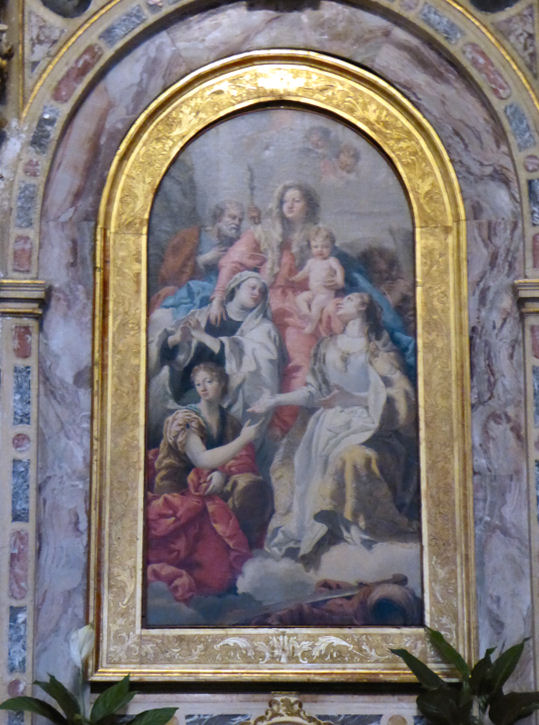
The middle,
confession, chapel has a very nice Virgin and Child with Saints
Francesca Romana and Eurosia of 1777 by
Giandomenico Tiepolo (the son) (see photo right) formerly in the
church of
Sant'Agnese. Before the 1960s
renovations this painting was over the high altar.
The first chapel,
the baptistery, has a triptych of
Virgin and Child with Saints James and Leonard described as 'school of Bellini'.
It sits on the rosso Verona marble monument to Giordano and Marco Forzatè.
The former was a Benedictine and a monastic reformer as well as coming
from one of the dominant local feudal families. That the family later
intermarried with the Carrara possibly helps explain Giordano's later
becoming know as beato. He is buried in
San Benedetto Vecchio.
On the church's back wall, to the left of the door, is Saint
Agnes in Glory
recently restored.
An exceptional polychromed terracotta statue of the Virgin and Child Enthroned,
c. 1468–70, by Giovanni de Fondulis.
Campanile
Restored in the 19th century.
Lost art
Ten panels that made up a polyptych of 1456-8 by Giorgio Schiavone (real
name Juraj Čulinović) are now in the National Gallery in London. Called
The San Niccolò Altarpiece it was probably made for the chapel
of Giovanni di Roberti in this church, later inherited by the
Frigimelinca family. The central panel of the
Virgin and Child is flanked by full and half-length panels depicting
saints and a Pietà. The artist signed his name on a creased
cartellino on the front of the Virgin’s throne - 'the work of Sclavoni,
Squarcione’s pupil’.
|
|
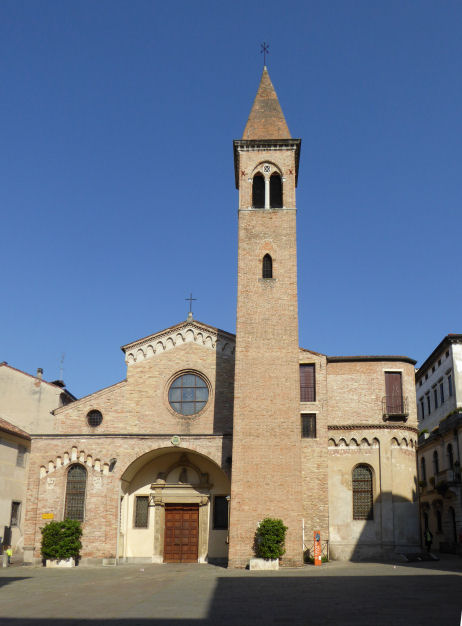 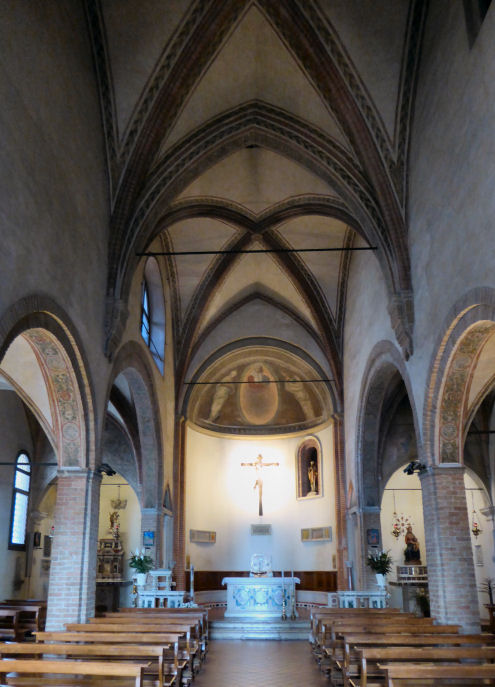
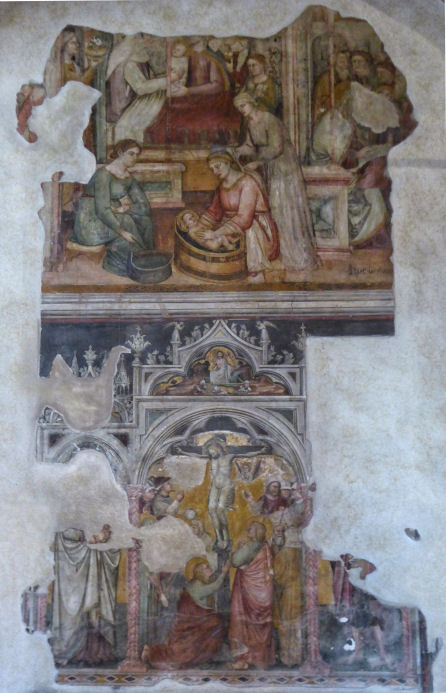
|
|
San Pietro Apostolo
Via San Pietro |
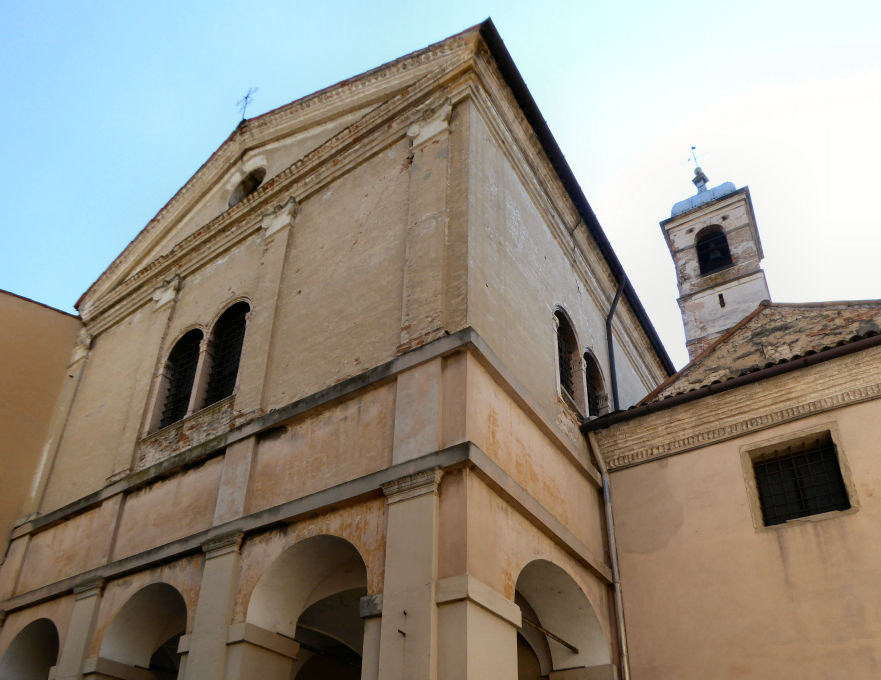 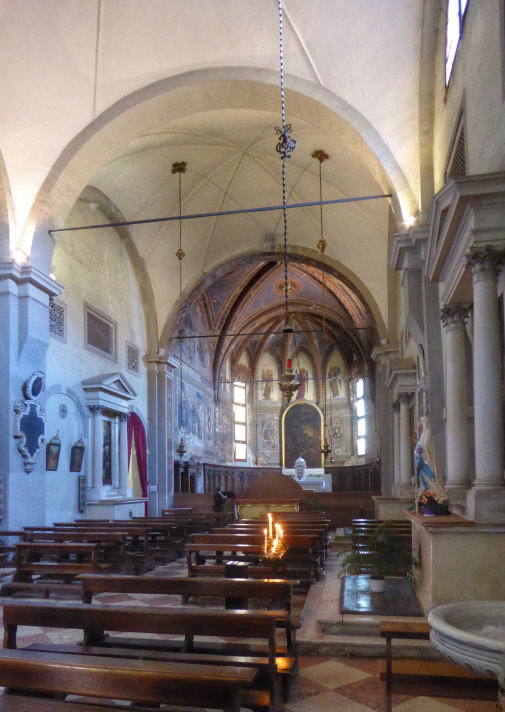
History
A church was known to have existed here in
the 4th century, a rebuilding of 1026 followed destruction by Hun invaders
around 900, and saw it passing to Benedictine nuns. Enlarged in the 14th
century, substantial work in the 18th century and heavy restoration in the 19th and
20th centuries.
Following the Napoleonic suppressions of 1809 the nuns remained for a few
years and monks from
San Prosdocimo came here too, bringing
with them the body of Saint Eustochium,
which is
still here.
Interior
Has the appearance of being aisleless but the aisles are behind a wall on
the left and doors on the right. The nave has two pairs of shallow plain
side altars. The deep choir is a riot of dark but well-illuminated fresco
decoration. The longer and higher enclosed left- hand aisle is dedicated to
Saint Eustochium and has her remains and a fresco-decorated ceiling. The
right-hand aisle has two spaces that are more like chapels.
Art highlights
A painted altarpiece by Varotari (or Campagnola) of
The Giving of the Keys, which is over the high altar, and Palma Giovane's
The Fall of Saint Paul (see below left) which is over the second altar on the left.
A polychromed terracotta relief, with a painted background, depicting The Lamentation, c.1480–90, by the circle of Bartolomeo Bellano,
a Paduan student of Donatello.
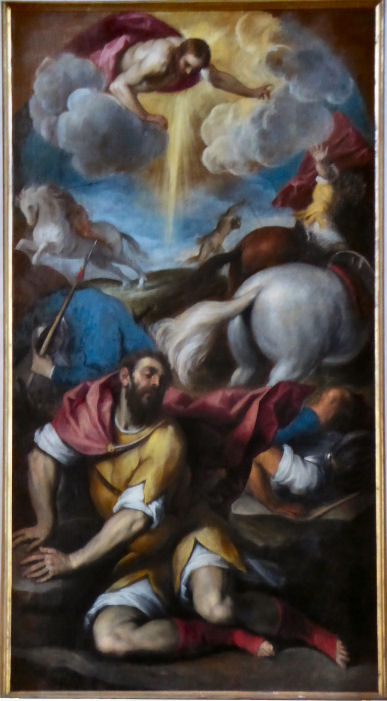
Lost art
The rather fine 1447 San Pietro Polyptych by Francesco de'Franceschi is now in the Eremitani Civic Museum - all twelve
panels, but without the original frame. Not much is known about this
artist but he may have collaborated with Antonio Vivarini in Venice.
The (unusually round) floor tomb stone of Antonio and Catharina Maggi da
Bassano (see below right), a celebrated jurist and his wife, from this church, possibly
installed in front of the high altar, is now in the V&A in London. It was
made in 1520 by Vincenzo and Gian Matteo Grandi. The square space in the
middle may once have contained an engraved brass panel.
In January 2021 Laura Jacobus (who wrote the book on the Scrovegni Chapel)
gave an online lecture for Birkbeck College in London on the little Giusto
de' Menabuoi Coronation of the Virgin triptych in the National
Gallery. In it she put forward the theory that the work was made for a
young woman entering a convent, specifically the Benedictine convent here,
and further that she could have been a younger daughter of the Scrovegni
family, who had connections here and with the nearby San Nicolò complex.
She admitted that the theory is speculative, to say the least, but it is
tempting too.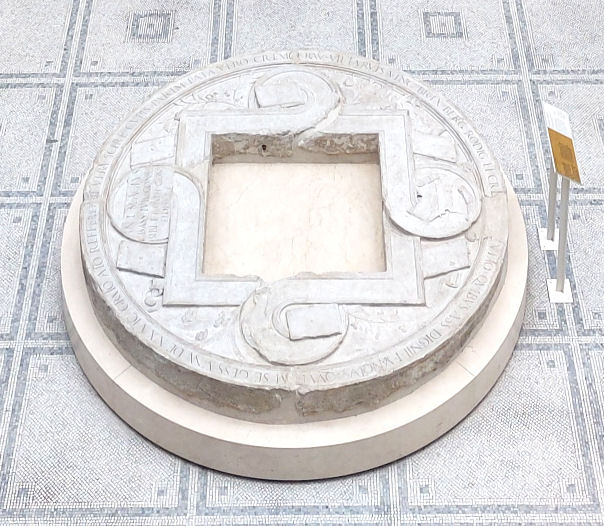
Opening times
9.00-12.00 Tuesday, Thursday and Saturday
|
|
San Prosdocimo
Via San Prosdocimo |
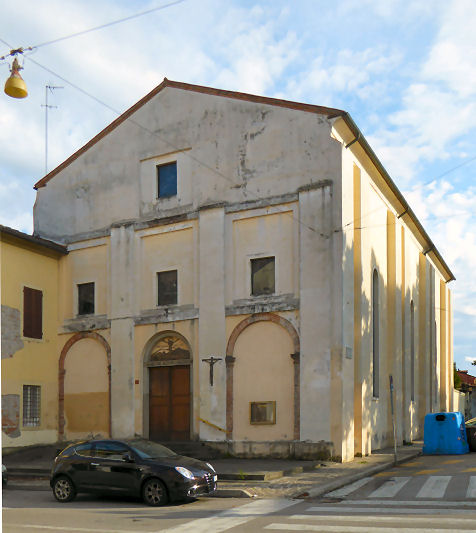 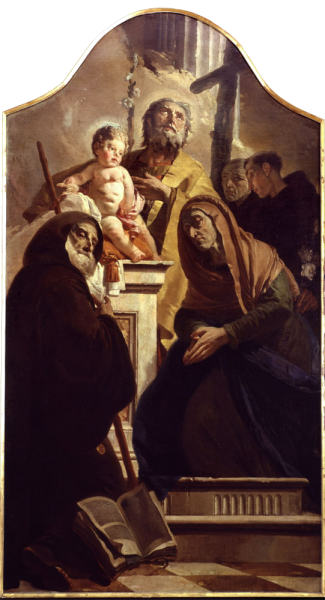
History
A church with medieval origins and named for Saint Prosdocimus,
the first bishop of Padua from the 4th century. Also known as the Duomo dei Militari,
formerly the church of a monastery of Benedictine nuns, following
Napoleonic suppression it was used as an army bakery and warehouse.
Following restoration work it became a parish church for the military.
After the earthquake of the 3rd of June 2012 the church was declared
unsafe and closed, but following restoration work it was officially
reopened on November 5th 2019 - the façade now looking much better than it
did when I took the photo in 2017.
Lost art
Giambattista Tiepolo painted an altarpiece showing Saint
Joseph with the Infant Jesus and Saints Francis of Paola, Anne, Anthony,
and Peter of Alcantara (see left) for this church in c.
1730/35. It's now in the Accademia in Venice.
|
|
San Tomaso
Becket
Via San Tomaso |
|
Sant'Alberto Magno
Via Guglielmo Marconi |
|
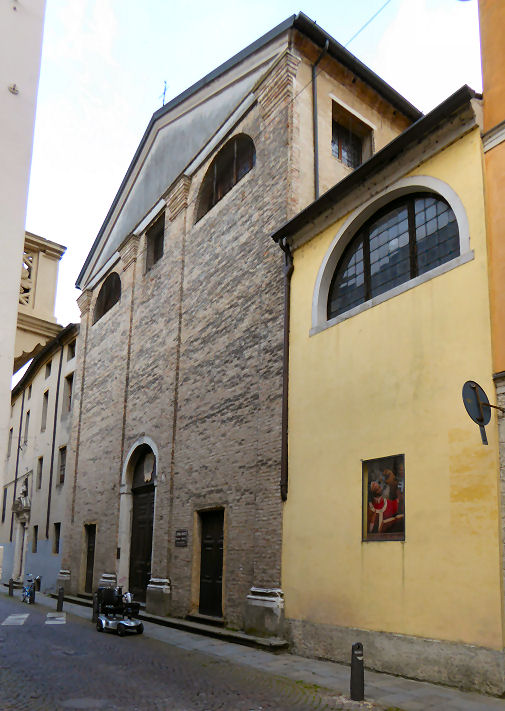
History
Baroque, built in the 17th century on the
site of earlier churches. Until 1890 it was run by the secular priests of
San Filippo Neri.
Interior
Inside are said to be works by A. Bonazza, Bonaccorsi, Ferrari, Pellizzari,
Francesco Maffei and a Crucifix attributed to Donatello. The ceiling has
fifteen
canvases from the 17th and 18th centuries depicting the Mysteries of the
Rosary.
The church also has a collection of more than a
thousand relics, including the heart of Filippo Neri and a portrait of him
which sweated twenty-seven times in 1632.
The sacristy houses the Museo di San Tommaso Becket, founded in 1966, which has
medieval frescoes, fabrics, liturgical furnishings, manuscripts,
archaeological items, goldsmiths work and paintings, including a
Virgin and Child Enthroned with Saints from the mid-1440s by Antonio Vivarini
and Giovanni d'Alemagna, from an altarpiece made for the church of San
Moisè in Venice. (See Lost art below.)
The church features in the Italian TV series Don
Matteo, about a crime-solving priest from Gubbio, that has run to 12
seasons.
Lost art
Two panels, depicting Saints Peter and Jerome and Saints Francis
and Mark which flanked the Virgin and Child Enthroned with Saints
by Antonio Vivarini and Giovanni d'Alemagna mentioned above are in the
National Gallery in London.
Opening times
At the whim of the parish
|
|

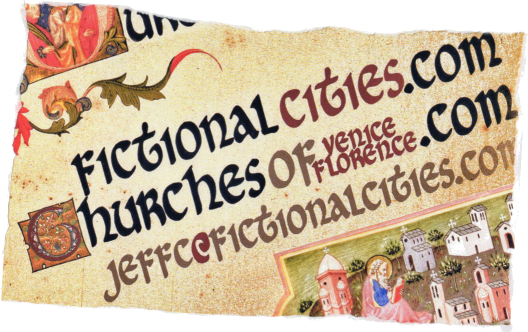 |
|
Sant'Agnese
Via Dante |
 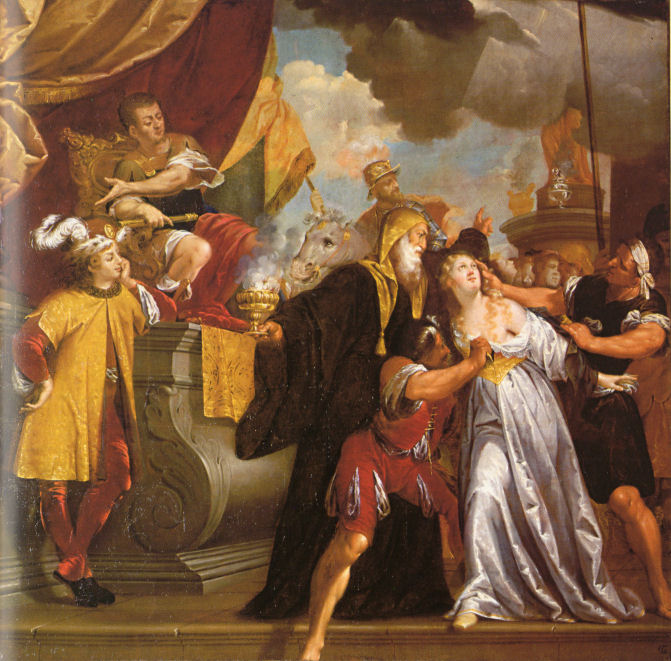
History
A church is said to been here in the 12th century. First documented in
1202 as a parish church. This 13th century structure underwent
restoration and expansion from the early 16th century, retaining its
single-nave interior. After Napoleon the church lost its parish status and
was later passed to the missionary Fathers of the Sacred Heart who lived
here until 1939.
It fell out of use during the Second World War and on October 7, 1948 was
deconsecrated. It's art was moved to San Nicolò and the Episcopal Palace and the building
was sold and later made into a garage, which it remained until the late
1990s. A portico was removed in the 20th century. Now abandoned and
falling down, it was sold in 2011 to be converted to flats, but not much
progress has been made, the scaffolding and graffiti visible in the photo
having been there now for several years.
The facade with renaissance doorway by Giovanni Maria Mosca -
oriented to the east - was probably covered in fresco in the 16th century.
Interior The interior has been gutted.
Campanile A Romanesque bell tower of the 13th century.
Lost art
Paintings by Francesco Minorello, a pupil of Luca Ferrari, depicting the life of Saint Agnes (St
Agnes refusing Gifts and the Martyrdom of Sant'Agnese at the
Gallows) are now in the Episcopal Palace.
Over other altars were works by Giulio Cirello, another pupil of Ferrari - St Agnes
Urged to Marry the Son of the Prophet (aka St Agnes Beaten by the
Roman Prefect) (see left) and St Martha as a Nun Sprays Holy Water on a Dragon. The former, at least, is
also in the Episcopal Palace, and was restored in 2000.
An altarpiece of 1777 by Giandomenico Tiepolo of the
Virgin and Child with Saints Francesca Romana and Eurosia, formerly
on the first altar on the right, is now in
San Niccolò.
|
Sant'Andrea
Via Sant'Andrea |
History
Dedicated to Saint Andrew the Apostle, the original church here was
built before 1130 and in 1640 was completely rebuilt. In 1875 the single
nave was transformed into a nave and aisles separated by Corinthian
columns, with decoration reflecting contemporary taste. The work was
finished in 1884 and the 'unfashionable' art previously in the church was
dispersed. Some restoration in the 1920s, the church was consecrated on
October 17th 1941. Paduan Arrigo Boito, writer of libretti for
Verdi and lover of Eleonora Duse, was baptized here on 19 March 1842. The
building was damaged by the earthquake of the 3rd of June 2012.
Interior
The ceiling is decorated with paintings by Antonio Grinzato, but
before the 19th century interventions showed The Apotheosis of
St. Andrew by Giambattista Mengardi . The apse has an altar taken from
the demolished church of San Marco which has three marble panels - The
Sacrifice of Isaac, The Supper at Emmaus and The Paschal Lamb -
by Francesco Bonazza. An altarpiece depicting the Virgin and Child
with Saint Andrew by Giovan Pietro Possenti. In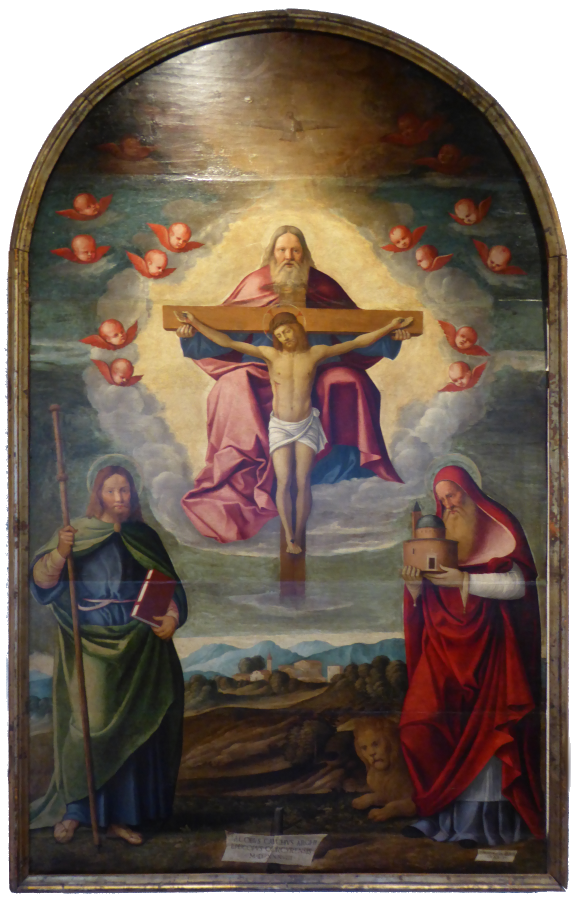 the aisles and over the
side altars are works from various sources and periods, including Saint
Francis Xavier by Natale Plache, from the Gesuiti church demolished
in the late 18th century and a Saint Martin in Glory of the 17th
century, once the high altarpiece of the church of San Martino. the aisles and over the
side altars are works from various sources and periods, including Saint
Francis Xavier by Natale Plache, from the Gesuiti church demolished
in the late 18th century and a Saint Martin in Glory of the 17th
century, once the high altarpiece of the church of San Martino.
Lost art
An early-16th- century altarpiece depicting The Trinity with
Saints James and Jerome by Girolamo di Santacroce (see right)
has been in the Eremetani Civic Museum since 1894.
The Cat of Saint Andrew
In front of the church is the famous Cat of Saint Andrew
(see photo from 1918 far right) which
traditionally is said to mark the highest point of the city. It's a rough stone
lion taken as a war trophy from the fortress of Este in 1209 by local
residents. When the lion was returned at the end of the conflict a
copy was made.
After being knocked down several times in recent years (the most recent in
2013, when a van hit it) it was finally reassembled by Paduan sculptor
Antonio Pennello. |
|
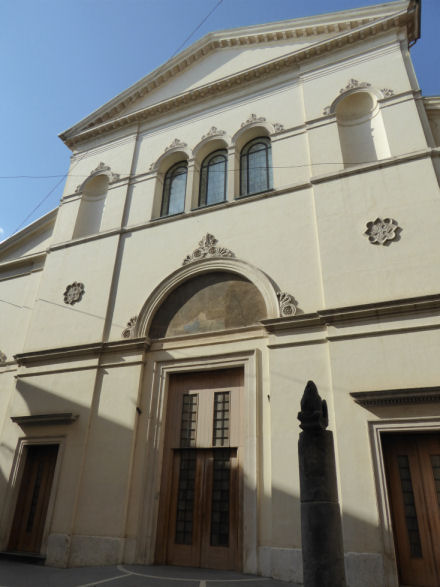
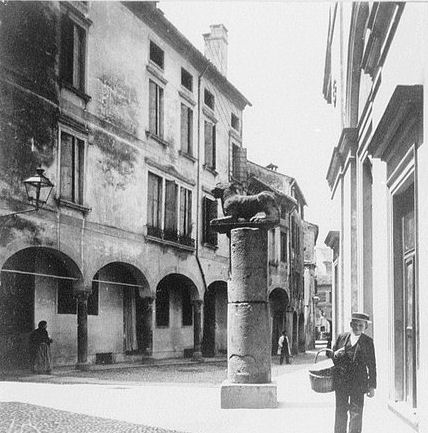
|


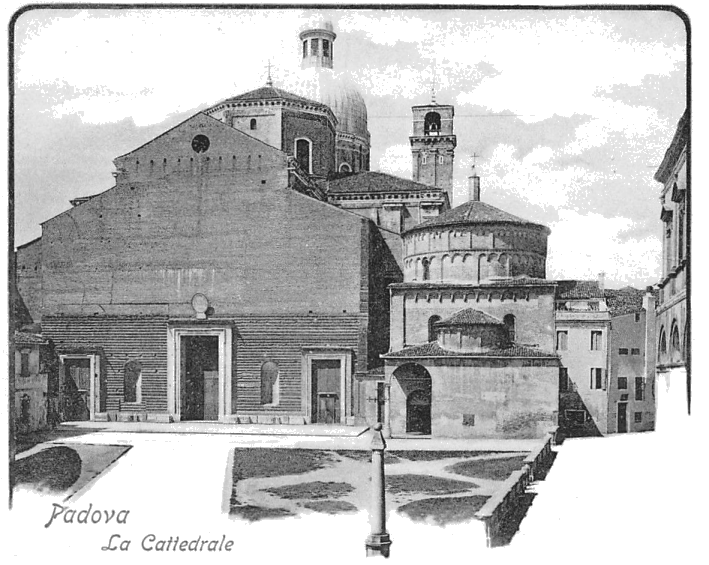
 Art
Art Giotto
- it was as a Giotto
that Petrarch bequeathed it to his friend Francesco da Carrara.
Giotto
- it was as a Giotto
that Petrarch bequeathed it to his friend Francesco da Carrara.







 History
History







 History
History


 History
History








 . Inside it's aisleless tall and octagonal (or maybe
square with the corners chopped off) and decorated with the marble panels
and stucco typical of the 18th century. Sharp left as you enter, and down
some stairs, is the unserene Chapel of the Holy Sepulchre. The small Presbytery and separate
choir beyond are all marble and stucco too, but the large sacristy is much
plainer and more solemn.
. Inside it's aisleless tall and octagonal (or maybe
square with the corners chopped off) and decorated with the marble panels
and stucco typical of the 18th century. Sharp left as you enter, and down
some stairs, is the unserene Chapel of the Holy Sepulchre. The small Presbytery and separate
choir beyond are all marble and stucco too, but the large sacristy is much
plainer and more solemn. 






















 the aisles and over the
side altars are works from various sources and periods, including Saint
Francis Xavier by Natale Plache, from the Gesuiti church demolished
in the late 18th century and a Saint Martin in Glory of the 17th
century, once the high altarpiece of the church of San Martino.
the aisles and over the
side altars are works from various sources and periods, including Saint
Francis Xavier by Natale Plache, from the Gesuiti church demolished
in the late 18th century and a Saint Martin in Glory of the 17th
century, once the high altarpiece of the church of San Martino.
